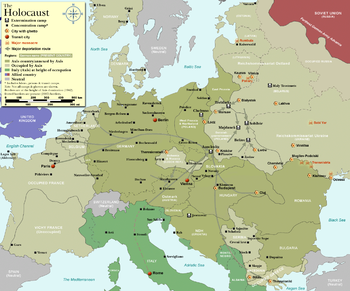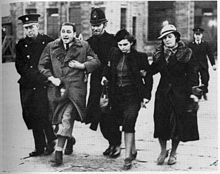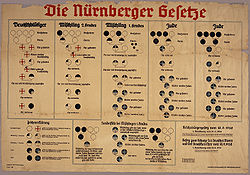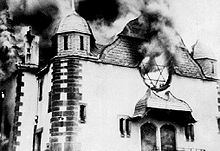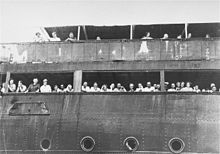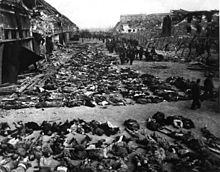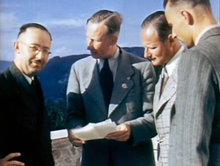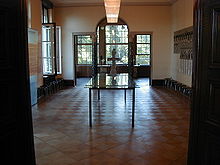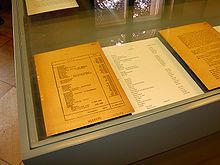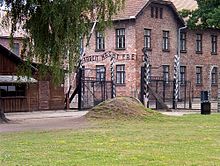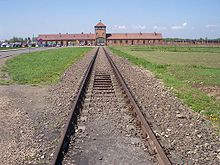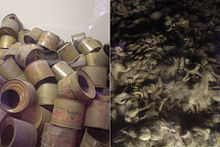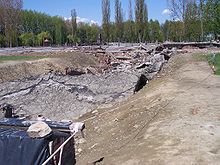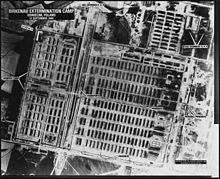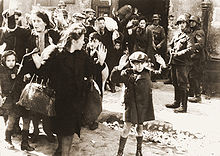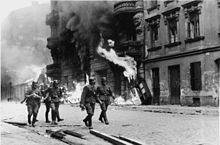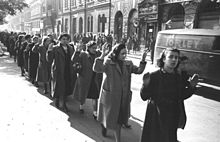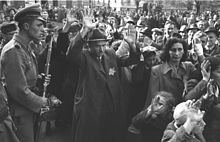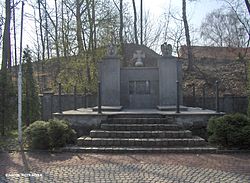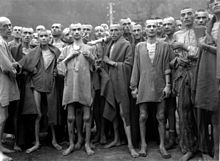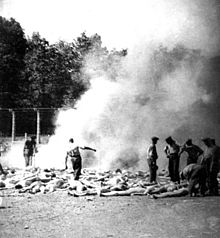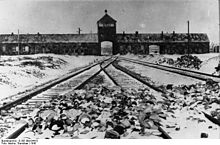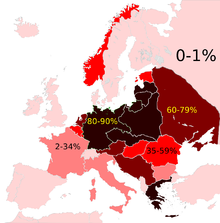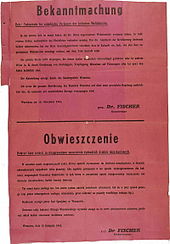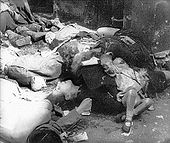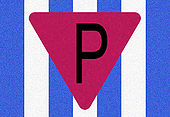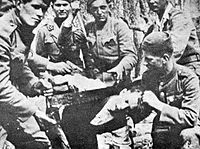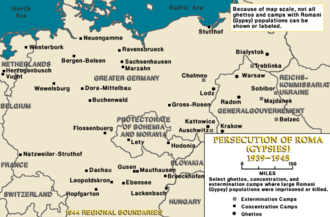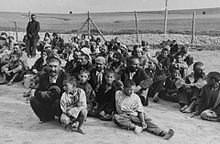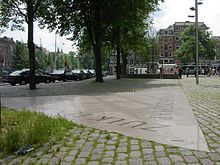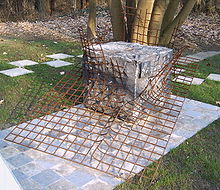
The Holocaust
Did you know...
SOS Children, an education charity, organised this selection. SOS Children has looked after children in Africa for forty years. Can you help their work in Africa?
The Holocaust (from the Greek ὁλόκαυστος holókaustos: hólos, "whole" and kaustós, "burnt") also known as the Shoah (Hebrew: השואה, HaShoah, "catastrophe"; Yiddish: חורבן, Churben or Hurban, from the Hebrew for "destruction"), was the mass murder or genocide of approximately six million Jews during World War II, a programme of systematic state-sponsored murder by Nazi Germany, led by Adolf Hitler and the Nazi Party, throughout German-occupied territory.
Of the nine million Jews who had resided in Europe before the Holocaust, approximately two-thirds were killed. Over one million Jewish children were killed in the Holocaust, as were approximately two million Jewish women and three million Jewish men. A network of over 40,000 facilities in Germany and German-occupied territory were used to concentrate, hold, and kill Jews and other victims.
Some scholars argue that the mass murder of the Romani and people with disabilities should be included in the definition, and some use the common noun "holocaust" to describe other Nazi mass murders, including those of Soviet prisoners of war, Polish and Soviet civilians, and homosexuals. Recent estimates based on figures obtained since the fall of the Soviet Union indicates some ten to eleven million civilians and prisoners of war were intentionally murdered by the Nazi regime.
The persecution and genocide were carried out in stages. Various laws to remove the Jews from civil society, most prominently the Nuremberg Laws, were enacted in Germany years before the outbreak of World War II. Concentration camps were established in which inmates were subjected to slave labor until they died of exhaustion or disease. Where Germany conquered new territory in eastern Europe, specialized units called Einsatzgruppen murdered Jews and political opponents in mass shootings.
The occupiers required Jews and Romani to be confined in overcrowded ghettos before being transported by freight train to extermination camps where, if they survived the journey, most were systematically killed in gas chambers. Every arm of Germany's bureaucracy was involved in the logistics that led to the genocides, turning the Third Reich into what one Holocaust scholar has called "a genocidal state".
Etymology and use of the term
The term holocaust comes from the Greek word holókauston, referring to an animal sacrifice offered to a god in which the whole (olos) animal is completely burnt (kaustos). For hundreds of years, the word "holocaust" was used in English to denote great massacres, but since the 1960s, the term has come to be used by scholars and popular writers to refer to the Nazi genocide of Jews. The television mini-series Holocaust is credited with introducing the term into common parlance after 1978.
The biblical word Shoah (שואה) (also spelled Sho'ah and Shoa), meaning "calamity", became the standard Hebrew term for the Holocaust as early as the 1940s, especially in Europe and Israel. Shoah is preferred by many Jews for a number of reasons, including the theologically offensive nature of the word "holocaust", which they take to refer to the Greek pagan custom.
The Nazis used a euphemistic phrase, the " Final Solution to the Jewish Question" (German: Endlösung der Judenfrage), and the phrase "Final Solution" has been widely used as a term for the genocide of the Jews. Nazis used the phrase "lebensunwertes Leben" ( Life unworthy of life) in reference to their victims in an attempt to justify the killings.
Distinctive features
Institutional collaboration
Michael Berenbaum writes that Germany became a "genocidal state." "Every arm of the country's sophisticated bureaucracy was involved in the killing process. Parish churches and the Interior Ministry supplied birth records showing who was Jewish; the Post Office delivered the deportation and denaturalization orders; the Finance Ministry confiscated Jewish property; German firms fired Jewish workers and disenfranchised Jewish stockholders." The universities refused to admit Jews, denied degrees to those already studying, and fired Jewish academics; government transport offices arranged the trains for deportation to the camps; German pharmaceutical companies tested drugs on camp prisoners; companies bid for the contracts to build the crematoria; detailed lists of victims were drawn up using the Dehomag (IBM Germany) company's punch card machines, producing meticulous records of the killings. As prisoners entered the death camps, they were made to surrender all personal property, which was catalogued and tagged before being sent to Germany to be reused or recycled. Berenbaum writes that the Final Solution of the Jewish question was "in the eyes of the perpetrators ... Germany's greatest achievement." Through a concealed account, the German national bank helped launder valuables stolen from the victims.
Saul Friedländer writes that: "Not one social group, not one religious community, not one scholarly institution or professional association in Germany and throughout Europe declared its solidarity with the Jews." He writes that some Christian churches declared that converted Jews should be regarded as part of the flock, but even then only up to a point. Friedländer argues that this makes the Holocaust distinctive because antisemitic policies were able to unfold without the interference of countervailing forces of the kind normally found in advanced societies, such as industry, small businesses, churches, and other vested interests and lobby groups.
Ideology and scale
In other genocides, pragmatic considerations such as control of territory and resources were central to the genocide policy. Yehuda Bauer argues that:
The basic motivation [of the Holocaust] was purely ideological, rooted in an illusionary world of Nazi imagination, where an international Jewish conspiracy to control the world was opposed to a parallel Aryan quest. No genocide to date had been based so completely on myths, on hallucinations, on abstract, nonpragmatic ideology—which was then executed by very rational, pragmatic means.
German historian Eberhard Jäckel wrote in 1986 that one distinctive feature of the Holocaust was that
never before had a state with the authority of its responsible leader decided and announced that a specific human group, including its aged, its women and its children and infants, would be killed as quickly as possible, and then carried through this resolution using every possible means of state power.
The killings were systematically conducted in virtually all areas of Nazi-occupied territory in what are now 35 separate European countries. It was at its most severe in Central and Eastern Europe, which had more than seven million Jews in 1939. About five million Jews were killed there, including three million in occupied Poland and over one million in the Soviet Union. Hundreds of thousands also died in the Netherlands, France, Belgium, Yugoslavia, and Greece. The Wannsee Protocol makes it clear that the Nazis intended to carry their "final solution of the Jewish question" to Britain and all neutral states in Europe, such as Ireland, Switzerland, Turkey, Sweden, Portugal, and Spain.
Anyone with three or four Jewish grandparents was to be exterminated without exception. In other genocides, people were able to escape death by converting to another religion or in some other way assimilating. This option was not available to the Jews of occupied Europe, unless their grandparents had converted before 18 January 1871. All persons of recent Jewish ancestry were to be exterminated in lands controlled by Germany.
Extermination camps
The use of camps equipped with gas chambers for the purpose of systematic mass extermination of peoples was a unique feature of the Holocaust and unprecedented in history. Never before had there existed places with the express purpose of killing people en masse. These were established at Auschwitz, Belzec, Chełmno, Jasenovac, Majdanek, Maly Trostenets, Sobibor, and Treblinka.
Medical experiments
A distinctive feature of Nazi genocide was the extensive use of human subjects in "medical" experiments. According to Raul Hilberg, "German physicians were highly Nazified, compared to other professionals, in terms of party membership," and some carried out experiments at Auschwitz, Dachau, Buchenwald, Ravensbrück, Sachsenhausen, and Natzweiler concentration camps.
The most notorious of these physicians was Dr. Josef Mengele, who worked in Auschwitz. His experiments included placing subjects in pressure chambers, testing drugs on them, freezing them, attempting to change eye colour by injecting chemicals into children's eyes, and various amputations and other surgeries. The full extent of his work will never be known because the truckload of records he sent to Dr. Otmar von Verschuer at the Kaiser Wilhelm Institute was destroyed by von Verschuer. Subjects who survived Mengele's experiments were almost always killed and dissected shortly afterwards.
He worked extensively with Romani children. He would bring them sweets and toys, and personally take them to the gas chamber. They would call him "Onkel (Uncle) Mengele". Vera Alexander was a Jewish inmate at Auschwitz who looked after 50 sets of Romani twins:
I remember one set of twins in particular: Guido and Ina, aged about four. One day, Mengele took them away. When they returned, they were in a terrible state: they had been sewn together, back to back, like Siamese twins. Their wounds were infected and oozing pus. They screamed day and night. Then their parents—I remember the mother's name was Stella—managed to get some morphine and they killed the children in order to end their suffering.
Development and execution
Origins
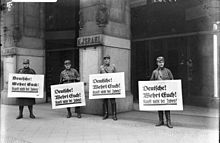
Yehuda Bauer, Raul Hilberg, and Lucy Dawidowicz maintained that from the Middle Ages onward, German society and culture were suffused with antisemitism, and that there was a direct ideological link from medieval pogroms to the Nazi death camps.
The second half of the 19th century saw the emergence in Germany and Austria-Hungary of the Völkisch movement, developed by such thinkers as Houston Stewart Chamberlain and Paul de Lagarde. The movement presented a pseudoscientific, biologically based racism that viewed Jews as a race locked in mortal combat with the Aryan race for world domination. Völkisch antisemitism drew upon stereotypes from Christian antisemitism, but differed in that Jews were considered to be a race rather than a religion. In a speech before the Reichstag in 1895, völkisch leader Hermann Ahlwardt called Jews "predators" and "cholera bacilli" who should be "exterminated" for the good of the German people. In his best-selling 1912 book Wenn ich der Kaiser wär (If I were the Kaiser), Heinrich Class, leader of the völkisch group Alldeutscher Verband, urged that all German Jews be stripped of their German citizenship and be reduced to Fremdenrecht (alien status). Class also urged that Jews be excluded from all aspects of German life, forbidden to own land, hold public office, or participate in journalism, banking, and the liberal professions. Class defined a Jew as anyone who was a member of the Jewish religion on the day the German Empire was proclaimed in 1871, or anyone with at least one Jewish grandparent. During the German Empire, völkisch notions and pseudoscientific racism had become common and accepted throughout Germany, with the educated professional classes of the country, in particular, adopting an ideology of human inequality. Though the völkisch parties were defeated in the 1912 Reichstag elections, being all but wiped out, antisemitism was incorporated into the platforms of the mainstream political parties. The National Socialist German Workers' Party (Nazi Party; NSDAP) was founded in 1920 as an offshoot of the völkisch movement, and adopted their antisemitism. In a 1986 essay, German historian Hans Mommsen wrote about the situation in post–World War I Germany that:
If one emphasizes the indisputably important connection in isolation, one should not then force a connection with Hitler's weltanschauung [worldview], which was in no ways original itself, in order to derive from it the existence of Auschwitz ... Thoughts about the extermination of the Jews had long been current, and not only for Hitler and his satraps. Many of these found their way to the NSDAP from the Deutschvölkisch Schutz-und Trutzbund [German Racial Union for Protection and Defiance], which itself had been called into life by the Pan-German Union.
Tremendous scientific and technological changes in Germany during the late 19th and early 20th centuries, together with the growth of the welfare state, created widespread hopes that utopia was at hand and that soon all social problems could be solved. At the same time a racist, social Darwinist, and eugenicist world-view which declared some people to be more biologically valuable than others was common. Historian Detlev Peukert states that the Shoah did not result solely from antisemitism, but was a product of the "cumulative radicalization" in which "numerous smaller currents" fed into the "broad current" that led to genocide. After the First World War, the pre-war mood of optimism gave way to disillusionment as German bureaucrats found social problems to be more insoluble than previously thought, which in turn led them to place increasing emphasis on saving the biologically "fit" while the biologically "unfit" were to be written off. The economic strains of the Great Depression led many in the German medical establishment to advocate the idea of euthanisation of the "incurable" mentally and physically disabled as a cost-saving measure to free up money to care for the curable. By the time the Nazis came to power in 1933, a tendency already existed in German social policy to save the racially "valuable" while seeking to rid society of the racially "undesirable".
Hitler was open about his hatred of Jews. In his book Mein Kampf, he gave warning of his intention to drive them from Germany's political, intellectual, and cultural life. He did not write that he would attempt to exterminate them, but he is reported to have been more explicit in private. As early as 1922, he allegedly told Major Joseph Hell, at the time a journalist:
Once I really am in power, my first and foremost task will be the annihilation of the Jews. As soon as I have the power to do so, I will have gallows built in rows—at the Marienplatz in Munich, for example—as many as traffic allows. Then the Jews will be hanged indiscriminately, and they will remain hanging until they stink; they will hang there as long as the principles of hygiene permit. As soon as they have been untied, the next batch will be strung up, and so on down the line, until the last Jew in Munich has been exterminated. Other cities will follow suit, precisely in this fashion, until all Germany has been completely cleansed of Jews.
The German historian Hans Mommsen claimed that there were three types of antisemitism in Germany:
One should differentiate between the cultural antisemitism symptomatic of the German conservatives – found especially in the German officer corps and the high civil administration – and mainly directed against the Eastern Jews on the one hand, and völkisch antisemitism on the other. The conservative variety functions, as Shulamit Volkov has pointed out, as something of a "cultural code." This variety of German antisemitism later on played a significant role insofar as it prevented the functional elite from distancing itself from the repercussions of racial antisemitism. Thus, there was almost no relevant protest against the Jewish persecution on the part of the generals or the leading groups within the Reich government. This is especially true with respect to Hitler's proclamation of the "racial annihilation war" against the Soviet Union.
Besides conservative antisemitism, there existed in Germany a rather silent anti-Judaism within the Catholic Church, which had a certain impact on immunising the Catholic population against the escalating persecution. The famous protest of the Catholic Church against the euthanasia program was, therefore, not accompanied by any protest against the Holocaust.
The third and most vitriolic variety of antisemitism in Germany (and elsewhere) is the so-called völkisch antisemitism or racism, and this is the foremost advocate of using violence. Anyhow, one has to be aware that even Hitler until 1938 and possibly 1939 still relied on enforced emigration to get rid of German Jewry; and there did not yet exist any clear-cut concept of killing them. This, however, does not mean that the Nazis elsewhere on all levels did not hesitate to use violent methods, and the inroads against Jews, Jewish shops, and institutions show that very clearly. But there did not exist any formal annihilation program until the second year of the war. It came into being after the "reservation" projects had failed. That, however, does not mean that those methods did not include a lethal component.
Legal repression and emigration
Right from the establishment of the Third Reich, Nazi leaders proclaimed the existence of a Volksgemeinschaft ("people's community"). Nazi policies divided the population into two categories, the Volksgenossen ("national comrades"), who belonged to the Volksgemeinschaft, and the Gemeinschaftsfremde ("community aliens"), who did not. Nazi policies about repression divided people into three types of enemies, the "racial" enemies such as the Jews and the Gypsies who were viewed as enemies because of their "blood"; political opponents such as Marxists, liberals, Christians and the "reactionaries" who were viewed as wayward "National Comrades"; and moral opponents such as homosexuals, the "work-shy" and habitual criminals, also seen as wayward "National Comrades". The last two groups were to be sent to concentration camps for "re-education", with the aim of eventual absorption into the Volksgemeinschaft, though some of the moral opponents were to be sterilized, as they were regarded as "genetically inferior". "Racial" enemies such as the Jews could, by definition, never belong to the Volksgemeinschaft; they were to be totally removed from society. German historian Detlev Peukert wrote that the National Socialists' "goal was an utopian Volksgemeinschaft, totally under police surveillance, in which any attempt at nonconformist behaviour, or even any hint or intention of such behaviour, would be visited with terror". Peukert quotes policy documents on the "Treatment of Community Aliens" from 1944, which (though never implemented) showed the full intentions of Nazi social policy: "persons who ... show themselves [to be] unable to comply by their own efforts with the minimum requirements of the national community" were to be placed under police supervision, and if this did not reform them, they were to be taken to a concentration camp.
Leading up to the March 1933 Reichstag elections, the Nazis intensified their campaign of violence against the opposition. With the co-operation of local authorities, they set up concentration camps for extrajudicial imprisonment of their opponents. One of the first, at Dachau, opened on 9 March 1933. Initially the camp contained primarily communists and Social Democrats. Other early prisons—for example, in basements and storehouses run by the Sturmabteilung (SA) and less commonly by the Schutzstaffel (SS)—were consolidated by mid-1934 into purpose-built camps outside the cities, run exclusively by the SS. The initial purpose of the camps was to serve as a deterrent by terrorizing those Germans did not conform to the Volksgemeinschaft. Those sent to the camps included the "educable", whose wills could be broken into becoming "National Comrades", and the "biologically depraved", who were to be sterilized, were to be held permanently, and over time were increasingly subject to extermination through labor, i.e. being worked to death.
Throughout the 1930s, the legal, economic, and social rights of Jews were steadily restricted. The Israeli historian Saul Friedländer writes that, for the Nazis, Germany drew its strength "from the purity of its blood and from its rootedness in the sacred German earth." On 1 April 1933, there occurred a boycott of Jewish businesses, which was the first national antisemitic campaign, initially planned for a week, but called off after one day owing to lack of popular support. In 1933, a series of laws were passed which contained Aryan paragraphs to exclude Jews from key areas: the Law for the Restoration of the Professional Civil Service, the first antisemitic law passed in the Third Reich; the Physicians' Law; and the Farm Law, forbidding Jews from owning farms or taking part in agriculture. Jewish lawyers were disbarred, and in Dresden, Jewish lawyers and judges were dragged out of their offices and courtrooms and beaten. At the insistence of then president Paul von Hindenburg, Hitler added an exemption allowing Jewish civil servants who were veterans of the First World War, or whose fathers or sons had served, to remain in office. Hitler revoked this exemption in 1937. Jews were excluded from schools and universities (the Law to Prevent Overcrowding in Schools), from belonging to the Journalists' Association, and from being owners or editors of newspapers. The Deutsche Allgemeine Zeitung of 27 April 1933 wrote:
A self-respecting nation cannot, on a scale accepted up to now, leave its higher activities in the hands of people of racially foreign origin . . . Allowing the presence of too high a percentage of people of foreign origin in relation to their percentage in the general population could be interpreted as an acceptance of the superiority of other races, something decidedly to be rejected.
In July 1933, the Law for the Prevention of Hereditarily Diseased Offspring calling for compulsory sterilization of the "inferior" was passed. This major eugenic policy led to over 200 Hereditary Health Courts (Erbgesundheitsgerichte) being set up, under whose rulings over 400,000 people were sterilized against their will during the Nazi period.
In 1935, Hitler introduced the Nuremberg Laws, which: prohibited Jews from marrying or having sex with "Aryans" (the Law for the Protection of German Blood and German Honour), stripped German Jews of their citizenship and deprived them of all civil rights. Hitler described the "Blood Law" in particular "the attempt at a legal regulation of a problem, which in the event of further failure would then have through law to be transferred to the final solution of the National Socialist Part."Hitler said that if the "Jewish problem" cannot be solved by these laws, it "must then be handed over by law to the National-Socialist Party for a final solution." The " final solution", or "Endlösung", became the standard Nazi euphemism for the extermination of the Jews. In January 1939, he said in a public speech: "If international-finance Jewry inside and outside Europe should succeed once more in plunging the nations into yet another world war, the consequences will not be the Bolshevization of the earth and thereby the victory of Jewry, but the annihilation (vernichtung) of the Jewish race in Europe." Footage from this speech was used to conclude the 1940 Nazi propaganda movie The Eternal Jew (Der ewige Jude), whose purpose was to provide a rationale and blueprint for eliminating the Jews from Europe.
Jewish intellectuals were among the first to leave. The philosopher Walter Benjamin left for Paris on 18 March 1933. Novelist Leon Feuchtwanger went to Switzerland. The conductor Bruno Walter fled after being told that the hall of the Berlin Philharmonic would be burned down if he conducted a concert there: the Frankfurter Zeitung explained on 6 April that Walter and fellow conductor Otto Klemperer had been forced to flee because the government was unable to protect them against the mood of the German public, which had been provoked by "Jewish artistic liquidators." Albert Einstein was visiting the U.S. on 30 January 1933. He returned to Ostende in Belgium, never to set foot in Germany again, and calling events there a "psychic illness of the masses"; he was expelled from the Kaiser Wilhelm Society and the Prussian Academy of Sciences, and his citizenship was rescinded. When Germany annexed Austria in 1938, Sigmund Freud and his family fled from Vienna to England. Saul Friedländer writes that when Max Liebermann, honorary president of the Prussian Academy of Arts, resigned his position, not one of his colleagues expressed a word of sympathy, and he was still ostracized at his death two years later. When the police arrived in 1943 with a stretcher to deport his 85-year-old bedridden widow, she committed suicide with an overdose of barbiturates rather than be taken.
Kristallnacht (1938)
On 7 November 1938, Jewish minor Herschel Grünspan assassinated Nazi German diplomat Ernst vom Rath in Paris. This incident was used by the Nazis as a pretext to go beyond legal repression to large-scale physical violence against Jewish Germans. What the Nazis claimed to be spontaneous "public outrage" was in fact a wave of pogroms instigated by the Nazi party, and carried out by SA members and affiliates throughout Nazi Germany, at the time consisting of Germany proper, Austria and Sudetenland. These pogroms became known as Reichskristallnacht ("the Night of Broken Glass", literally "Crystal Night"), or November pogroms. Jews were attacked and Jewish property was vandalized, over 7,000 Jewish shops and 1,668 synagogues (almost every synagogue in Germany) were damaged or destroyed. The death toll is assumed to be much higher than the official number of 91 dead. 30,000 were sent to concentration camps, including Dachau, Sachsenhausen, Buchenwald, and Oranienburg concentration camp, where they were kept for several weeks, and released when they could either prove that they were about to emigrate in the near future, or transferred their property to the Nazis. Coinciding with Kristallnacht was the 11 November 1938 passage of Regulations Against Jews' Possession of Weapons, which made it illegal for Jews to possess firearms or other weapons (see The 1938 German Weapons Act). German Jewry was collectively made responsible for restitution of the material damage of the pogroms, amounting to several hundred thousand Reichsmarks, and furthermore had to pay an "atonement tax" of more than a billion Reichsmarks.
After these pogroms, Jewish emigration from Germany accelerated, while public Jewish life in Germany ceased to exist.
Resettlement and deportation
Before the war, the Nazis considered mass exportation of German (and subsequently the European) Jewry from Europe. Hitler's agreement to the 1938–9 Schacht Plan, and the continued flight of thousands of Jews from Hitler's clutches for an extended period when the Schacht Plan came to nothing, indicate that the preference for a concerted genocide of the type that came later did not yet exist.
Plans to reclaim former German colonies such as Tanganyika and South West Africa for Jewish resettlement were halted by Hitler, who argued that no place where "so much blood of heroic Germans had been spilled" should be made available as a residence for the "worst enemies of the Germans". Diplomatic efforts were undertaken to convince the other former colonial powers, primarily the United Kingdom and France, to accept expelled Jews in their colonies. Areas considered for possible resettlement included British Palestine, Italian Abyssinia, British Rhodesia, French Madagascar, and Australia.
Of these areas, Madagascar was the most seriously discussed. Heydrich called the Madagascar Plan a "territorial final solution"; it was a remote location, and the island's unfavorable conditions would hasten deaths. Approved by Hitler in 1938, the resettlement planning was carried out by Eichmann's office, only being abandoned once the mass killing of Jews began in 1941. In retrospect, although futile, this plan did constitute an important psychological step on the path to the Holocaust. The end of the Madagascar Plan was announced on 10 February 1942. The German Foreign Office was given the official explanation that, due to the war with the Soviet Union, Jews were to be "sent to the east".
Nazi bureaucrats also developed plans to deport Europe's Jews to Siberia. Palestine was the only location to which any Nazi relocation plan succeeded in producing significant results, by means of an agreement begun in 1933 between the Zionist Federation of Germany (die Zionistische Vereinigung für Deutschland) and the Nazi government, the Haavara Agreement. This agreement resulted in the transfer of about 60,000 German Jews and $100 million from Germany to Palestine, up until the outbreak of World War II.
Early measures
In German occupied Poland

Germany's invasion of Poland in September 1939 increased the urgency of the "Jewish Question". Poland, was home to about two million Jews ( nearly nine percent of the population), in centuries-old communities.
Himmler's right-hand man, Reinhard Heydrich, recommended concentrating all the Polish Jews in ghettos in major cities, where they would be put to work for the German war industry. The ghettos would be in cities located on railway junctions in order to furnish, in Heydrich's words, "a better possibility of control and later deportation." During his interrogation in 1961, Adolf Eichmann recalled that this "later deportation" actually meant "physical extermination."
| “ |
I ask nothing of the Jews except that they should disappear. |
” |
|
— Hans Frank, Nazi governor of Poland. |
||
In September, Himmler appointed Heydrich head of the Reich Main Security Office (Reichssicherheitshauptamt or RSHA, not to be confused with the RuSHA). This body was to oversee the work of the SS, the Security Police (SD), and the Gestapo in occupied Poland, and carry out the policy towards the Jews described in Heydrich's report. The first organized murders of Jews by German forces occurred during Operation Tannenberg and through Selbstschutz units. Later, the Jews were herded into ghettos, mostly in the General Government area of central Poland, where they were put to work under the Reich Labor Office headed by Fritz Sauckel. Here many thousands died from maltreatment, disease, starvation, and exhaustion, but there was still no program of systematic killing. There is no doubt, however, that the Nazis saw forced labor as a form of extermination. The expression Vernichtung durch Arbeit ("destruction through work") was frequently used.
Although it was clear by 1941 that the SS hierarchy was determined to embark on a policy of killing all the Jews under German control, there was still opposition to this policy within the Nazi regime, although the motive was economic, not humanitarian. Hermann Göring, who had overall control of the German war industry, and the German army's Economics Department, argued that the enormous Jewish labor force assembled in the General Government area (more than a million able-bodied workers) was an asset too valuable to waste while Germany was preparing to invade the Soviet Union.
In other occupied countries
When Germany occupied Norway, the Netherlands, Luxembourg, Belgium, and France in 1940, and Yugoslavia and Greece in 1941, antisemitic measures were also introduced into these countries, although the pace and severity varied greatly from country to country according to local political circumstances. Jews were removed from economic and cultural life and were subject to various restrictive laws, but physical deportation did not occur in most places before 1942. The Vichy regime in occupied France actively collaborated in persecuting French Jews. Germany's allies Italy, Hungary, Romania, Bulgaria and Finland were pressured to introduce antisemitic measures, but for the most part they did not comply until compelled to do so. During the course of the war some 900 Jews and 300 Roma passed through the concentration camp Banjica in Belgrade, intended primarily for Serbian communists, royalists and other patriots who resisted occupation. The German puppet regime in Croatia, on the other hand, began actively persecuting Jews on its own initiative, so the Legal Decree on the Nationalization of the Property of Jews and Jewish Companies was declared on 10 October 1941 in the Independent State of Croatia.
General Government and Lublin reservation (Nisko plan)
On 28 September 1939, Germany gained control over the Lublin area through the German-Soviet agreement in exchange for Lithuania. According to the Nisko Plan, they set up the Lublin-Lipowa Reservation in the area. The reservation was designated by Adolf Eichmann, who was assigned the task of removing all Jews from Germany, Austria and the Protectorate of Bohemia and Moravia. They shipped the first Jews to Lublin less than three weeks later on 18 October 1939. The first train loads consisted of Jews deported from Austria and the Protectorate of Bohemia and Moravia. By 30 January 1940, a total of 78,000 Jews had been deported to Lublin from Germany, Austria and Czechoslovakia. On 12 and 13 February 1940, the Pomeranian Jews were deported to the Lublin reservation, resulting in Pomeranian Gauleiter Franz Schwede-Coburg to be the first to declare his Gau " judenrein" ("free of Jews"). On 24 March 1940 Hermann Göring put the Nisko Plan on hold, and abandoned it entirely by the end of April. By the time the Nisko Plan was stopped, the total number of Jews who had been transported to Nisko had reached 95,000, many of whom had died from starvation.
In July 1940, due to the difficulties of supporting the increased population in the General Government, Hitler had the deportations temporarily halted.
In October 1940, Gauleiters Josef Bürckel and Robert Heinrich Wagner oversaw Operation Bürckel, the expulsion of the Jews into unoccupied France from their Gaues and the parts of Alsace-Lorraine that had been annexed that summer to the Reich. Only those Jews in mixed marriages were not expelled. The 6,500 Jews affected by Operation Bürckel were given at most two hours warning on the night of 22–23 October 1940, before being rounded up. The nine trains carrying the deported Jews crossed over into France "without any warning to the French authorities", who were not happy to receive them. The deportees had not been allowed to take any of their possessions with them, these being confiscated by the German authorities. The German Foreign Minister Joachim von Ribbentrop treated the ensuing complaints by the Vichy government over the expulsions in a "most dilatory fashion". As a result, the Jews expelled in Operation Bürckel were interned in harsh conditions by the Vichy authorities at the camps in Gurs, Rivesaltes and Les Milles while awaiting a chance to return them to Germany.
During 1940 and 1941, murder of large numbers of Jews in German-occupied Poland continued, and the deportation of Jews to the General Government was undertaken. The deportation of Jews from Germany, particularly Berlin, was not officially completed until 1943. (Many Berlin Jews were able to survive in hiding.) By December 1939, 3.5 million Jews were crowded into the General Government area.
Concentration and labor camps (1933–1945)
From the beginning of the Third Reich concentration camps were founded, initially as places of incarceration. Though the death rate in the concentration camps was high, with a mortality rate of 50%, they were not designed to be killing centres. (By 1942, six large extermination camps had been established in Nazi-occupied Poland, which were built solely for mass killings.) After 1939, the camps increasingly became places where Jews and POWs were either killed or made to work as slave laborers, undernourished and tortured. It is estimated that the Germans established 15,000 camps and subcamps in the occupied countries, mostly in eastern Europe. New camps were founded in areas with large Jewish, Polish intelligentsia, communist, or Roma and Sinti populations, including inside Germany. The transportation of prisoners was often carried out under horrifying conditions using rail freight cars, in which many died before reaching their destination.
Extermination through labour was a policy of systematic extermination — camp inmates would literally be worked to death, or worked to physical exhaustion, when they would be gassed or shot. Slave labour was used in war production, for example producing V-2 rockets at Mittelbau-Dora, and various armaments around the Mauthausen-Gusen concentration camp complex.
Upon admission, some camps tattooed prisoners with a prisoner ID. Those fit for work were dispatched for 12 to 14 hour shifts. Before and after, there were roll calls that could sometimes last for hours, with prisoners regularly dying of exposure.
Ghettos (1940–1945)
- Main ghettos: Białystok, Budapest, Kraków, Kovno, Łódź, Lvov, Riga, Vilna, Warsaw
After the invasion of Poland, the Nazis established ghettos in which Jews and some Romani were confined until they were eventually shipped to extermination camps. The first order for the establishment of the councils came in a letter dated 29 September 1939 from Heydrich to the heads of the Einsatzgruppen. Each ghetto was run by a Judenrat (Jewish council) of German-appointed Jewish community leaders, who were responsible for the day-to-day running of the ghetto, including the distribution of food, water, heat, medicine, and shelter. The basic strategy adopted by the councils was one of trying to minimise losses, largely by cooperating with Nazi authorities (or their surrogates), accepting the increasingly terrible treatment, and petitioning for better conditions and clemency.
Councils were also expected to make arrangements for deportations to extermination camps, thus the defining moment that tested the courage and character of each Judenrat came when they were asked to provide a list of names of the next group to be deported. The Judenrat members went through the tried and tested methods of delay, bribery, stonewalling, pleading, and argumentation, until finally a decision had to be made. Some, like Chaim Rumkowski, argued that their responsibility was to save the Jews who could be saved, and that therefore others had to be sacrificed; others argued, following Maimonides, that not a single individual should be handed over who had not committed a capital crime. Judenrat leaders such as Dr. Joseph Parnas in Lviv, who refused to compile a list, were shot. On 14 October 1942, the entire Judenrat of Byaroza committed suicide rather than cooperate with the deportations.
The importance of the councils in facilitating the persecution and murder of ghetto inhabitants was not lost on the Germans: one official was emphatic that "the authority of the Jewish council be upheld and strengthened under all circumstances", another that "Jews who disobey instructions of the Jewish council are to be treated as saboteurs." When such cooperation crumbled, as happened in the Warsaw ghetto after the Jewish Combat Organisation displaced the council's authority, the Germans lost control.
The Warsaw Ghetto was the largest, with 380,000 people, and the Łódź Ghetto the second largest, holding 160,000. They were, in effect, immensely crowded prisons, described by Michael Berenbaum as instruments of "slow, passive murder." Though the Warsaw Ghetto contained 30% of the population of Warsaw, it occupied only 2.4% of the city's area, averaging 9.2 people per room.
From 1940 through 1942, starvation and disease, especially typhoid, killed hundreds of thousands. Over 43,000 residents of the Warsaw ghetto died there in 1941, more than one in ten; in Theresienstadt, more than half the residents died in 1942.
The Germans came, the police, and they started banging houses: "Raus, raus, raus, Juden raus." ... [O]ne baby started to cry ... The other baby started crying. So the mother urinated in her hand and gave the baby a drink to keep quiet ... [When the police had gone], I told the mothers to come out. And one baby was dead ... from fear, the mother [had] choked her own baby.
— Abraham Malik, describing his experience in the Kovno Ghetto.
Himmler ordered the start of the deportations on 19 July 1942, and three days later, on 22 July, the deportations from the Warsaw Ghetto began; over the next 52 days, until 12 September 300,000 people from Warsaw alone were transported in freight trains to the Treblinka extermination camp. Many other ghettos were completely depopulated.
The first ghetto uprising occurred in September 1942 in the small town of Łachwa in south-east Poland. Though there were armed resistance attempts in the larger ghettos in 1943, such as the Warsaw Ghetto Uprising and the Białystok Ghetto Uprising, in every case they failed against the overwhelming Nazi military force, and the remaining Jews were either killed or deported to the death camps.
Pogroms (1939–1942)
A number of deadly pogroms by local populations occurred during the Second World War, some with Nazi encouragement, and some spontaneously. This included the Iaşi pogrom in Romania on 30 June 1941, in which as many as 14,000 Jews were killed by Romanian residents and police, and the Jedwabne pogrom, in which between 380 and 1,600 Jews were killed by local Poles in July 1941.
Death squads (1941–1943)
The German invasion of the Soviet Union in June 1941 opened a new phase. The Holocaust intensified after the Nazis occupied Lithuania, where close to 80% of the country's 220,000 Jews were exterminated before the end of the year. The Soviet territories occupied by early 1942, including all of Belarus, Estonia, Latvia, Lithuania, Ukraine, and Moldova and most Russian territory west of the line Leningrad-Moscow- Rostov, contained about three million Jews, including hundreds of thousands who had fled Poland in 1939.
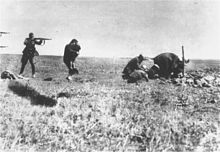
Members of the local populations in certain occupied Soviet territories participated actively in the killings of Jews and others. In Lithuania, Latvia and western Ukraine, locals were deeply involved in the murder of Jews from the very beginning of the German occupation. The Latvian Arajs Kommando was an example of an auxiliary unit involved in these killings. To the south, Ukrainians killed approximately 24,000 Jews. In addition, Latvian and Lithuanian units left their own countries, and committed murders of Jews in Belarus, and Ukrainians served as concentration and death camp guards in Poland. Ustaše militia in Croatian areas also carried out acts of persecution and murder. Ultimately it was the Germans who organized and channelled these local participants in the Holocaust.
Many of the mass killings were carried out in public, a change from previous practice. German witnesses to these killings emphasized the participation of the locals. The massacres committed by the Einsatzgruppen were usually justified under the grounds of anti-partisan or anti-bandit operations, but the German historian Andreas Hillgruber wrote that this was merely an excuse for the German Army's considerable involvement in the Holocaust in Russia and the terms "war crimes" and "crimes against humanity" were indeed correct labels for what happened. Hillgruber maintained that the slaughter of about 2.2 million defenceless men, women and children for the reasons of racist ideology cannot possibly be justified for any reason, and that those German generals who claimed that the Einsatzgruppen were a necessary anti-partisan response were lying.
Army co-operation with the SS in anti-partisan and anti-Jewish operations was close and intensive. In mid-1941, the SS Cavalry Brigade commanded by Hermann Fegelein during the course of "anti-partisan" operations in the Pripyat Marshes killed 699 Red Army soldiers, 1,100 partisans and 14,178 Jews. Before the operation, Fegelein had been ordered to shoot all adult Jews while driving the women and children into the marshes. After the operation, General Max von Schenckendorff, who commanded the rear areas of Army Group Centre ordered on 10 August 1941 that all Wehrmacht security divisions when on anti-partisan duty should emulate Fegelein's example, and organized in Mogilev between 24–26 September 1941 a joint SS-Wehrmacht seminar on how best to kill Jews. The seminar ended with the 7th Company of Police Battalion 322 shooting 32 Jews at village called Knjashizy before the assembled officers as an example of how to "screen" the population for partisans. As the war diary of the Battalion 322 read:
The action, first scheduled as a training exercise was carried out under real-life conditions (ernstfallmässig) in the village itself. Strangers, especially partisans could not be found. The screening of the population, however resulted in 13 Jews, 27 Jewish women and 11 Jewish children, of which 13 Jews and 19 Jewish women were shot in co-operation with the Security Service
Based on what they had learned during the Mogilev seminar, one Wehrmacht officer told his men "Where the partisan is, there is the Jew and where the Jew is, there is the partisan". In Order #24 24 November 1941, the commander of the 707th division declared:
Jews and Gypsies:...As already has been ordered, the Jews have to vanish from the flat country and the Gypsies have to be annihilated too. The carrying out of larger Jewish actions is not the task of the divisional units. They are carried out by civilian or police authorities, if necessary ordered by the commandant of White Ruthenia, if he has special units at his disposal, or for security reasons and in the case of collective punishments. When smaller or larger groups of Jews are met in the flat country, they can be liquidated by divisional units or be massed in the ghettos near bigger villages designated for that purpose, where they can be handed over to the civilian authority or the SD.
The German historian Jürgen Förster, a leading expert on the subject of Wehrmacht war crimes argued the Wehrmacht played a key role in the Holocaust, and it is wrong to describe the Shoah as solely the work of the SS with the Wehrmacht as a passive and disapproving bystander.

Raul Hilberg writes that the German Einsatzgruppen commanders were ordinary citizens: the great majority were professionals, most were intellectuals, and they brought to bear all their skills and training, becoming efficient killers.
The large-scale killings of Jews in the occupied Soviet territories was assigned to SS formations called Einsatzgruppen ("task groups"), under the overall command of Heydrich. These had been used on a limited scale in Poland in 1939, but were now organized on a much larger scale. Einsatzgruppe A was assigned to the Baltic area, Einsatzgruppe B to Belarus, Einsatzgruppe C to north and central Ukraine, and Einsatzgruppe D to Moldova, south Ukraine, Crimea, and, during 1942, the north Caucasus.
According to Otto Ohlendorf at his trial, "the Einsatzgruppen had the mission to protect the rear of the troops by killing the Jews, Gypsies, Communist functionaries, active Communists, and all persons who would endanger the security." In practice, their victims were nearly all defenseless Jewish civilians (not a single Einsatzgruppe member was killed in action during these operations). By December 1941, the four Einsatzgruppen listed above had killed, respectively, 125,000, 45,000, 75,000, and 55,000 people—a total of 300,000 people—mainly by shooting or with hand grenades at mass killing sites outside the major towns.
The United States Holocaust Memorial Museum tells the story of one survivor of the Einsatzgruppen in Piryatin, Ukraine, when they killed 1,600 Jews on 6 April 1942, the second day of Passover:
I saw them do the killing. At 5:00 p.m. they gave the command, "Fill in the pits." Screams and groans were coming from the pits. Suddenly I saw my neighbour Ruderman rise from under the soil ... His eyes were bloody and he was screaming: "Finish me off!" ... A murdered woman lay at my feet. A boy of five years crawled out from under her body and began to scream desperately. "Mommy!" That was all I saw, since I fell unconscious.
The most notorious massacre of Jews in the Soviet Union was at a ravine called Babi Yar outside Kiev, where 33,771 Jews were killed in a single operation on 29–30 September 1941. The killing of all the Jews in Kiev was decided on by the military governor (Major-General Friedrich Eberhardt), the Police Commander for Army Group South (SS-Obergruppenführer Friedrich Jeckeln) and the Einsatzgruppe C Commander Otto Rasch. A mixture of SS, SD and Security Police, assisted by Ukrainian police carried out the killings. Although they not did participate in the killings, men of the 6th Army played a key role in rounding up the Jews of Kiev and transporting them to be shot at Babi Yar.
On Monday, the Jews of Kiev gathered by the cemetery, expecting to be loaded onto trains. The crowd was large enough that most of the men, women, and children could not have known what was happening until it was too late; by the time they heard the machine gun fire, there was no chance to escape. All were driven down a corridor of soldiers, in groups of ten, and then shot. A truck driver described the scene, as
one after the other, they had to remove their luggage, then their coats, shoes, and outer garments and also underwear ... Once undressed, they were led into the ravine which was about 150 meters long and 30 meters wide and a good 15 meters deep ... When they reached the bottom of the ravine they were seized by members of the Schutzpolizei and made to lie down on top of Jews who had already been shot ... The corpses were literally in layers. A police marksman came along and shot each Jew in the neck with a submachine gun ... I saw these marksmen stand on layers of corpses and shoot one after the other ... The marksman would walk across the bodies of the executed Jews to the next Jew, who had meanwhile lain down, and shoot him.
In August 1941 Himmler travelled to Minsk, where he personally witnessed 100 Jews being shot in a ditch outside the town, an event described by Karl Wolff in his diary. "Himmler's face was green. He took out his handkerchief and wiped his cheek where a piece of brain had squirted up onto it. Then he vomited." After recovering his composure, he lectured the SS men on the need to follow the "highest moral law of the Party" in carrying out their tasks.
New methods of mass murder
Starting in December 1939, the Nazis introduced new methods of mass murder by using gas. First, experimental gas vans equipped with gas cylinders and a sealed trunk compartment, were used to kill mental care clients of sanatoria in Pomerania, East Prussia, and occupied Poland, as part of an operation termed Action T4. In the Sachsenhausen concentration camp, larger vans holding up to 100 people were used from November 1941, using the engine's exhaust rather than a cylinder. These vans were introduced to the Chełmno extermination camp in December 1941, and another 15 of them were used by the Einsatzgruppen in the occupied Soviet Union. These gas vans were developed and run under supervision of the Reich Main Security Office, and were used to kill about 500,000 people, primarily Jews, but also Romani and others. The vans were carefully monitored and after a month of observation a report stated that "ninety seven thousand have been processed using three vans, without any defects showing up in the machines".
A need for new mass murder techniques was also expressed by Hans Frank, governor of the General Government, who noted that this many people could not be simply shot. "We shall have to take steps, however, designed in some way to eliminate them." It was this problem which led the SS to experiment with large-scale killings using poison gas. Finally, Christian Wirth seems to have been the inventor of the gas chamber.
Wannsee Conference and the Final Solution (1942–1945)
The Wannsee Conference was convened by Reinhard Heydrich on 20 January 1942 in the Berlin suburb of Wannsee and brought together some 15 Nazi leaders which included a number of state secretaries, senior officials, party leaders, SS officers and other leaders of government departments who were responsible for policies which were linked to Jewish issues. The initial purpose of the meeting was to discuss plans for a comprehensive solution to the "Jewish question in Europe." Heydrich intended to "outline the mass murders in the various occupied territories . . . as part of a solution to the European Jewish question ordered by Hitler . . . to ensure that they, and especially the ministerial bureaucracy, would share both knowledge and responsibility for this policy."
A copy of the minutes which were drawn up by Eichmann has survived, but on Heydrich's instructions, they were written up in "euphemistic language." Thus the exact words used at the meeting are not known. However, Heydrich addressed the meeting indicating the policy of emigration was superseded by a policy of evacuating Jews to the east. This was seen to be only a temporary solution leading up to a final solution which would involve some 11 million Jews living not only in territories controlled then by the Germans, but to major countries in the rest of the world including the UK, and the US. There was little doubt what the solution was: "Heydrich also made it clear what was understood by the phrase 'Final Solution': the Jews were to be annihilated by a combination of forced labour and mass murder."
The officials were told there were 2.3 million Jews in the General Government, 850,000 in Hungary, 1.1 million in the other occupied countries, and up to 5 million in the USSR, although 2 million of these were in areas still under Soviet control — a total of about 6.5 million. These would all be transported by train to extermination camps (Vernichtungslager) in Poland, where almost all of them would be gassed at once. In some camps, such as Auschwitz, those fit for work would be kept alive for a while, but eventually all would be killed. Göring's representative, Dr. Erich Neumann, gained a limited exemption for some classes of industrial workers.
Reaction
German public
In his 1983 book, Popular Opinion and Political Dissent in the Third Reich, Ian Kershaw examined the Alltagsgeschichte (history of everyday life) in Bavaria during the Nazi period. Describing the attitudes of most Bavarians, Kershaw argued that the most common viewpoint was indifference towards what was happening to the Jews. Kershaw argued that most Bavarians were vaguely aware of the Shoah, but were vastly more concerned about the war than about the "Final Solution to the Jewish Question". Kershaw made the analogy that "the road to Auschwitz was built by hate, but paved with indifference".
Kershaw's assessment that most Bavarians, and by implication most Germans, were indifferent to the Shoah faced criticism from the Israeli historian Otto Dov Kulka, an expert on public opinion in Nazi Germany, and the Canadian historian Michael Kater. Kater contended that Kershaw downplayed the extent of popular antisemitism, and that though admitting that most of the "spontaneous" antisemitic actions of Nazi Germany were staged, argued that because these actions involved substantial numbers of Germans, it is wrong to see the extreme antisemitism of the Nazis as coming solely from above. Kulka argued that most Germans were more antisemitic than Kershaw portrayed them in Popular Opinion and Political Dissent, and that rather than "indifference", "passive complicity" would be a better term to describe the reaction of the German people.
In a study focusing only on the views about Jews of Germans opposed to the Nazi regime, the German historian Christof Dipper in his 1983 essay "Der Deutsche Widerstand und die Juden" (translated into English as "The German Resistance and the Jews" in Yad Vashem Studies, Volume 16, 1984) argued that the majority of the anti-Nazi national-conservatives were antisemitic. Dipper wrote that for the majority of the national-conservatives "the bureaucratic, pseudo-legal deprivation of the Jews practiced until 1938 was still considered acceptable". Though Dipper noted no one in the German resistance supported the Holocaust, he also commented that the national-conservatives did not intend to restore civil rights to the Jews after the planned overthrow of Hitler. Dipper went on to argue that, based on such views held by opponents of the regime, "a large part of the German people...believed that a "Jewish Question" existed and had to be solved...".
A study conducted in 2012 established that in Berlin alone there were 3000 camps of various function and another 1300 were in Hamburg and its co-researcher concluded that it is unlikely that the German population could avoid knowing about the persecution considering such prevalence. Robert Gellately has argued that the German civilian population were, by and large, aware of what was happening. According to Gellately, the government openly announced the conspiracy through the media and civilians were aware of its every aspect except for the use of gas chambers. In contrast, some historical evidence indicates that the vast majority of Holocaust victims, prior to their deportation to concentration camps, were either unaware of the fate that awaited them or were in denial; they honestly believed that they were to be resettled.
International
Motivation
In his 1965 essay "Command and Compliance", which originated in his work as an expert witness for the prosecution at the Frankfurt Auschwitz Trials, the German historian Hans Buchheim wrote there was no coercion to murder Jews and others, and all who committed such actions did so out of free will. Buchheim wrote that chances to avoid executing criminal orders "...were both more numerous and more real than those concerned are generally prepared to admit...", and that he found no evidence that SS men who refused to carry out criminal orders were sent to concentration camps or executed. Moreover, SS rules prohibited acts of gratuitous sadism, as Himmler wished for his men to remain "decent", and that acts of sadism were taken on the individual initiative of those who were either especially cruel or who wished to prove themselves ardent National Socialists. Finally, he argued that those of a non-criminal bent who committed crimes did so because they wished to conform to the values of the group they had joined and were afraid of being branded "weak" by their colleagues if they refused.
In his 1992 book Ordinary Men: Reserve Police Battalion 101 and the Final Solution in Poland, Christopher Browning examined the German Ordnungspolizei Reserve Battalion 101, used to massacre and round up Jews for deportation to the Nazi death camps. The men of the battalion were middle-aged men of working-class background from Hamburg, who were unfit for military duty and were given no special training for genocide. The commander of the unit gave his men the choice of opting out of direct participation if they found it too unpleasant (for example, by being part of a passive cordon round the area of the killing). The majority chose not to exercise that option— fewer than 15 men out of a battalion of 500 did so. Influenced by the work of Stanley Milgram, Browning argued that the men of the battalion killed out of obedience to authority and peer pressure, not blood-lust or hatred. The general implication of the book is that when placed in a cohesive group setting, most people will obey commands given by an authority figure seen as legitimate, even if they find them morally reprehensible— a hypothesis studied in the Milgram Experiment.
The Russian historian Sergei Kudryashov studied the guards trained at the Trawniki concentration camp, who provided the bulk of personnel for the Operation Reinhard death camps. Some Trawniki guards were Red Army POWs who volunteered to join the SS in order to get out of the POW camps. The majority of the Trawniki men were Ukrainians or Volksdeutche, though there were also Russians, Poles, Latvians, Lithuanians, Tartars, Georgians, Armenians and Azerbaijanis amongst them. Kudryashov reported that he found there was little sign of antisemitism or any attraction to National Socialism among the Trawniki men, many of whom prior to their capture had been Communists. Despite the generally apathetic views of the Trawniki guards, the vast majority faithfully carried out the SS's expectations of how to mistreat Jews; the mistreatment of Jews by the Trawniki guards was "systematic and without any particular cause". Many, though not all of the Trawniki men executed Jews, and almost all of them while working as guards in the Operation Reinhard camps personally killed dozens of Jews. Following Christopher Browning, Kudryashov argued that the Trawniki men were examples of ordinary people becoming willing killers out of peer pressure and obedience to authority.
Extermination camps
| Camp name | Killed | Coordinates | Ref. |
|---|---|---|---|
| Auschwitz II | 1,000,000 | 50°2′9″N 19°10′42″E | |
| Belzec | 600,000 | 50°22′18″N 23°27′27″E | |
| Chełmno | 320,000 | 52°9′27″N 18°43′43″E | |
| Jasenovac | 58–97,000 | 45°16′54″N 16°56′6″E | |
| Majdanek | 360,000 | 51°13′13″N 22°36′0″E | |
| Maly Trostinets | 65,000 | 53°51′4″N 27°42′17″E | |
| Sobibor | 250,000 | 51°26′50″N 23°35′37″E | |
| Treblinka | 870,000 | 52°37′35″N 22°2′49″E |
During 1942, in addition to Auschwitz, five other camps were designated as extermination camps (Vernichtungslager) for the carrying out of the Reinhard plan. Two of these, Chełmno and Majdanek were already functioning as labor camps: these now had extermination facilities added to them. Three new camps were built for the sole purpose of killing large numbers of Jews as quickly as possible, at Belzec, Sobibor and Treblinka. A seventh camp, at Maly Trostinets in Belarus, was also used for this purpose. Jasenovac was an extermination camp where mostly ethnic Serbs were killed.
Extermination camps are frequently confused with concentration camps such as Dachau and Belsen, which were mostly located in Germany and intended as places of incarceration and forced labor for a variety of enemies of the Nazi regime (such as Communists and homosexuals). They should also be distinguished from slave labor camps, which were set up in all German-occupied countries to exploit the labor of prisoners of various kinds, including prisoners of war. In all Nazi camps there were very high death rates as a result of starvation, disease and exhaustion, but only the extermination camps were designed specifically for mass killing.
There was a place called the ramp where the trains with the Jews were coming in. They were coming in day and night, and sometimes one per day and sometimes five per day . . . Constantly, people from the heart of Europe were disappearing, and they were arriving to the same place with the same ignorance of the fate of the previous transport. And the people in this mass . . . I knew that within a couple of hours . . . ninety percent would be gassed.
— Rudolf Vrba, who worked on the Judenrampe in Auschwitz from August 18, 1942 to June 7, 1943.
The extermination camps were run by SS officers, but most of the guards were Ukrainian or Baltic auxiliaries. Regular German soldiers were kept well away.
Gas chambers
At the extermination camps with gas chambers all the prisoners arrived by train. Sometimes entire trainloads were sent straight to the gas chambers, but usually the camp doctor on duty subjected individuals to selections, where a small percentage were deemed fit to work in the slave labor camps; the majority were taken directly from the platforms to a reception area where all their clothes and other possessions were seized by the Nazis to help fund the war. They were then herded naked into the gas chambers. Usually they were told these were showers or delousing chambers, and there were signs outside saying "baths" and "sauna." They were sometimes given a small piece of soap and a towel so as to avoid panic, and were told to remember where they had put their belongings for the same reason. When they asked for water because they were thirsty after the long journey in the cattle trains, they were told to hurry up, because coffee was waiting for them in the camp, and it was getting cold.
According to Rudolf Höß, commandant of Auschwitz, bunker 1 held 800 people, and bunker 2 held 1,200. Once the chamber was full, the doors were screwed shut and solid pellets of Zyklon-B were dropped into the chambers through vents in the side walls, releasing toxic HCN, or hydrogen cyanide. Those inside died within 20 minutes; the speed of death depended on how close the inmate was standing to a gas vent, according to Höß, who estimated that about one third of the victims died immediately. Joann Kremer, an SS doctor who oversaw the gassings, testified that: "Shouting and screaming of the victims could be heard through the opening and it was clear that they fought for their lives." When they were removed, if the chamber had been very congested, as they often were, the victims were found half-squatting, their skin colored pink with red and green spots, some foaming at the mouth or bleeding from the ears.
The gas was then pumped out, the bodies were removed (which would take up to four hours), gold fillings in their teeth were extracted with pliers by dentist prisoners, and women's hair was cut. The floor of the gas chamber was cleaned, and the walls whitewashed. The work was done by the Sonderkommando, which were work units of Jewish prisoners. In crematoria 1 and 2, the Sonderkommando lived in an attic above the crematoria; in crematoria 3 and 4, they lived inside the gas chambers. When the Sonderkommando had finished with the bodies, the SS conducted spot checks to make sure all the gold had been removed from the victims' mouths. If a check revealed that gold had been missed, the Sonderkommando prisoner responsible was thrown into the furnace alive as punishment.
At first, the bodies were buried in deep pits and covered with lime, but between September and November 1942, on the orders of Himmler, they were dug up and burned. In early 1943, new gas chambers and crematoria were built to accommodate the numbers.
Another improvement we made over Treblinka was that we built our gas chambers to accommodate 2,000 people at one time, whereas at Treblinka their 10 gas chambers only accommodated 200 people each. The way we selected our victims was as follows: we had two SS doctors on duty at Auschwitz to examine the incoming transports of prisoners. The prisoners would be marched by one of the doctors who would make spot decisions as they walked by. Those who were fit for work were sent into the Camp. Others were sent immediately to the extermination plants. Children of tender years were invariably exterminated, since by reason of their youth they were unable to work. Still another improvement we made over Treblinka was that at Treblinka the victims almost always knew that they were to be exterminated and at Auschwitz we endeavored to fool the victims into thinking that they were to go through a delousing process. Of course, frequently they realized our true intentions and we sometimes had riots and difficulties due to that fact. Very frequently women would hide their children under the clothes but of course when we found them we would send the children in to be exterminated. We were required to carry out these exterminations in secrecy but of course the foul and nauseating stench from the continuous burning of bodies permeated the entire area and all of the people living in the surrounding communities knew that exterminations were going on at Auschwitz.
— Rudolf Höß, Auschwitz camp commandant, Nuremberg testimony.
Jewish resistance
In his seminal study of the Holocaust, The Destruction of the European Jews, the world's pre-eminent Holocaust scholar, Raul Hilberg, noted:
The reaction pattern of the Jews is characterized by almost complete lack of resistance. In marked contrast to German propaganda, the documentary evidence of Jewish resistance, overt or submerged, is very slight. On a European-wide scale the Jews had no resistance organization, no blueprint for armed action, no plan even for psychological warfare. They were completely unprepared. . . . Measured in German casualties, Jewish armed opposition shrinks into insignificance. . . . A large component of the entire [destruction] process depended on Jewish participation, from the simple acts of individuals to the organized activity in councils. . . . Jewish resistance organizations attempting to reverse the mass inertia spoke the words: "Do not be led like sheep to slaughter." Franz Stangl, who had commanded two death camps, was asked in a West German prison about his reaction to the Jewish victims. He said that only recently he had read a book about lemmings. It reminded him of Treblinka.
In his important study, Peter Longerich observes likewise: "On the Jewish side there was practically no resistance." Hilberg accounts for this compliant attitude by evoking the history of Jewish persecution: as had been the case so many times before down through the centuries, simply appealing to their oppressors, and complying with orders, would hopefully avoid inflaming the situation and so mitigate the damage done to the Jews until the onslaught abated. "There were many casualties in these times of stress, but always the Jewish community emerged once again like a rock from a receding tidal wave. The Jews had never disappeared from the earth." They were "caught in the straitjacket of their history", and the realisation that this time was different came too late.
Discussing the case of Warsaw, Timothy Snyder notes in a similar vein that it was only during the three months after the massive deportations of July–September 1942 that general agreement on the need for armed resistance was reached, and lays the passivity emanating from the conservative centre of Jewish politics at the door of the overall success the Jewish community had enjoyed by engaging in a quid pro quo with the pre-war Polish government. By the time of the biggest act of armed resistance, the Warsaw Ghetto Uprising of spring 1943, only a small minority of Polish Jews were still alive.
Yehuda Bauer and other historians argue that resistance consisted not only of physical opposition, but of any activity that gave the Jews dignity and humanity in humiliating and inhumane conditions.
In every ghetto, in every deportation train, in every labor camp, even in the death camps, the will to resist was strong, and took many forms. Fighting with the few weapons that would be found, individual acts of defiance and protest, the courage of obtaining food and water under the threat of death, the superiority of refusing to allow the Germans their final wish to gloat over panic and despair. Even passivity was a form of resistance. To die with dignity was a form of resistance. To resist the demoralizing, brutalizing force of evil, to refuse to be reduced to the level of animals, to live through the torment, to outlive the tormentors, these too were acts of resistance. Merely to give a witness of these events in testimony was, in the end, a contribution to victory. Simply to survive was a victory of the human spirit.
— Martin Gilbert. The Holocaust: The Jewish Tragedy.
Hilberg argued against overstating the extent of Jewish resistance, or using all-encompassing definitions of it like that deployed by Gilbert. "When relatively isolated or episodic acts of resistance are represented as typical, a basic characteristic of the German measures is obscured", namely that the merciless slaughter of peaceable innocent people is turned into some kind of battle. "The inflation of resistance has another consequence which has been of concern to those Jews who have regarded themselves as the actual resisters. If heroism is an attribute that should be assigned to every member of the European Jewish community, it will diminish the accomplishment of the few who took action." Finally, the blending of the passive majority with the active few was "not merely a form of dilution, which blurred the multitudinous problems of organizing a defense in a cautious, reluctant Jewish community; it was also a way of shutting off a great many questions about that community, its reasoning and survival strategy." Without posing these questions, Jewish history could not be written.
The most famous example of Jewish armed resistance was the Warsaw Ghetto Uprising of January 1943, when thousands of poorly armed Jewish fighters held the SS at bay for four weeks before being crushed by overwhelmingly superior forces. According to Jewish accounts, several hundred Germans were killed, while the Germans claimed to have lost 17 dead and 93 wounded. 13,000 Jews were killed during the uprising, and 57,885 were deported and gassed according to German figures. This uprising was followed by the uprising in the Treblinka extermination camp in May 1943, when about 200 inmates escaped from the camp after overpowering the guards. They killed a number of German guards and set the camp buildings ablaze, but 900 inmates were also killed, and out of the 600 who successfully escaped, only 40 survived the war. Two weeks later, there was an uprising in the Białystok Ghetto. In September, there was a short-lived uprising in the Vilna Ghetto. In October, 600 Jewish prisoners, including Jewish Soviet prisoners of war, attempted an escape at the Sobibor death camp. The prisoners killed 11 German SS officers and a number of camp guards. However, the killings were discovered, and the inmates were forced to run for their lives under heavy fire. 300 of the prisoners were killed during the escape. Most of the survivors either died in the minefields surrounding the camp or were recaptured and executed. About 60 survived and joined the Soviet partisans. On 7 October 1944, 250 Jewish Sonderkommandos (laborers) at Auschwitz attacked their guards and blew up Crematorium IV with explosives that female prisoners had smuggled in from a nearby factory. Three German guards were killed during the uprising, one of whom was stuffed into an oven. The Sonderkommandos attempted a mass breakout, but all 250 were killed soon after.
An estimated 20,000 to 30,000 Jewish partisans (see the list at the top of this section) actively fought the Nazis and their collaborators in Eastern Europe. They engaged in guerilla warfare and sabotage against the Nazis, instigated Ghetto uprisings, and freed prisoners. In Lithuania alone, they killed approximately 3,000 German soldiers. As many as 1.4 million Jewish soldiers fought in the Allied armies. Of these, approximately 40% served in the Red Army. About 200,000 Jewish soldiers serving in the Red Army died in the war. The Jewish Brigade, a unit of 5,000 Jewish volunteers from the British Mandate of Palestine, fought in the British Army. German-speaking Jewish volunteers from the Special Interrogation Group performed commando and sabotage operations against the Nazis behind front lines in the Western Desert Campaign.
In occupied Poland and Soviet territories, thousands of Jews fled into the swamps or forests and joined the partisans, although the partisan movements did not always welcome them. In Lithuania and Belarus, an area with a heavy concentration of Jews, and also an area which suited partisan operations, Jewish partisan groups saved thousands of Jewish civilians from extermination. No such opportunities existed for the Jewish populations of cities such as Budapest. However in Amsterdam, and other parts of the Netherlands, many Jews were active in the Dutch Resistance. Timothy Snyder wrote that "Other combatants in the Warsaw Uprising were veterans of the ghetto uprising of 1943. Most of these Jews joined the Home Army; others found the People's Army, or even the antisemitic National Armed Forces. Some Jews (or Poles of Jewish origin) were already enlisted in the Home Army and the People's Army. Almost certainly, more Jews fought in the Warsaw Uprising of August 1944 than in the Warsaw Ghetto Uprising of April 1943." Joining the partisans was an option only for the young and the fit who were willing to leave their families. Many Jewish families preferred to die together rather than be separated.
French Jews were also highly active in the French Resistance, which conducted a guerilla campaign against the Nazis and Vichy French authorities, assisted the Allies in their sweep across France, and supported Allied including Free French forces in the liberation of many occupied French cities. Although Jews made up only one percent of the French population, they made up fifteen to twenty percent of the French Resistance. The Jewish youth movement EEIF, which had originally shown support for the Vichy regime, was banned in 1943, and many of its older members formed armed resistance units. Zionist Jews also formed the Armee Juive (Jewish Army), which participated in armed resistance under a Zionist flag, and smuggled Jews out of the country. Both organizations merged in 1944, and participated in the liberation of Paris, Lyon, Toulouse, Grenoble, and Nice.
Many people think the Jews went to their deaths like sheep to the slaughter, and that's not true—it's absolutely not true. I worked closely with many Jewish people in the Resistance, and I can tell you, they took much greater risks than I did.
— Pieter Meerburg
For the great majority of Jews resistance could take only the passive forms of delay, evasion, negotiation, bargaining and, where possible, bribery of German officials. The Nazis encouraged this by forcing the Jewish communities to police themselves, through bodies such as the Reich Association of Jews (Reichsvereinigung der Juden) in Germany and the Jewish Councils ( Judenräte) in the urban ghettos in occupied Poland. They held out the promise of concessions in exchange for each surrender, enmeshing the Jewish leadership so deeply in well-intentioned compromise that a decision to stand and fight was never possible. Holocaust survivor Alexander Kimel wrote: "The youth in the Ghettos dreamed about fighting. I believe that although there were many factors that inhibited our responses, the most important factors were isolation and historical conditioning to accepting martyrdom."
The historical conditioning of the Jewish communities of Europe to accept persecution and avert disaster through compromise and negotiation was the most important factor in the failure to resist until the very end. The Warsaw Ghetto uprising took place only when the Jewish population had been reduced from 500,000 to 100,000, and it was obvious that no further compromise was possible. Paul Johnson writes: "The Jews had been persecuted for a millennium and a half and had learned from long experience that resistance cost lives rather than saved them. Their history, their theology, their folklore, their social structure, even their vocabulary trained them to negotiate, to pay, to plead, to protest, not to fight."
The Jewish communities were also systematically deceived about German intentions, and were cut off from most sources of news from the outside world. The Germans told the Jews that they were being deported to work camps – euphemistically calling it "resettlement in the East" – and maintained this illusion through elaborate deceptions all the way to the gas chamber doors (which were marked with labels stating that the chambers were for removal of lice) to avoid uprisings. As photographs testify, Jews disembarked at the railway stations at Auschwitz and other extermination camps carrying sacks and suitcases, clearly having no idea of the fate that awaited them. Rumours of the reality of the extermination camps filtered back only slowly to the ghettos, and were usually not believed, just as they were not believed when couriers such as Jan Karski, the Polish resistance fighter, conveyed them to the western Allies.
Climax
Heydrich was assassinated in Prague in June 1942. He was succeeded as head of the RSHA by Ernst Kaltenbrunner. Kaltenbrunner and Eichmann, under Himmler's close supervision, oversaw the climax of the Final Solution. During 1943 and 1944, the extermination camps worked at a furious rate to kill the hundreds of thousands of people shipped to them by rail from almost every country within the German sphere of influence. By the spring of 1944, up to 8,000 people were being gassed every day at Auschwitz.
Despite the high productivity of the war industries based in the Jewish ghettos in the General Government, during 1943 they were liquidated, and their populations shipped to the camps for extermination. The largest of these operations, the deportation of 100,000 people from the Warsaw Ghetto in early 1943, provoked the Warsaw Ghetto Uprising, which was suppressed with great brutality. Approximately 42,000 Jews were shot during the Operation Harvest Festival on 3–4 November 1943. At the same time, rail shipments arrived regularly from western and southern Europe. Few Jews were shipped from the occupied Soviet territories to the camps: the killing of Jews in this zone was left in the hands of the SS, aided by locally recruited auxiliaries. In any case, by the end of 1943 the Germans had been driven from most Soviet territory.
Shipments of Jews to the camps had priority on the German railways, and continued even in the face of the increasingly dire military situation after the Battle of Stalingrad at the end of 1942 and the escalating Allied air attacks on German industry and transport. Army leaders and economic managers complained at this diversion of resources and at the killing of irreplaceable skilled Jewish workers. By 1944, moreover, it was evident to most Germans not blinded by Nazi fanaticism that Germany was losing the war. Many senior officials began to fear the retribution that might await Germany and them personally for the crimes being committed in their name. But the power of Himmler and the SS within the German Reich was too great to resist, and Himmler could always evoke Hitler's authority for his demands.
In October 1943, Himmler gave a speech to senior Nazi Party officials gathered in Posen (now Poznań in western Poland). Here he came closer than ever before to stating explicitly that he was intent on exterminating the Jews of Europe:
I may here in this closest of circles allude to a question which you, my party comrades, have all taken for granted, but which has become for me the most difficult question of my life, the Jewish question ... I ask of you that what I say in this circle you really only hear and never speak of ... We come to the question: how is it with the women and children? I have resolved even here on a completely clear solution. I do not consider myself justified in eradicating the men—so to speak killing them or ordering them to be killed—and allowing the avengers in the shape of the children to grow up ... The difficult decision had to be taken, to cause this people to disappear from the earth.
The audience for this speech included Admiral Karl Dönitz and Armaments Minister Albert Speer. Dönitz successfully claimed at the Nuremberg trials that he had had no knowledge of the Final Solution. Speer, however, declared at the trial and in a subsequent interview that "If I didn't see it, then it was because I didn't want to see it." The text of this speech was not known at the time of their trials.
The scale of extermination slackened somewhat at the beginning of 1944 once the ghettos in occupied Poland were emptied, but on 19 March 1944, Hitler ordered the military occupation of Hungary, and Eichmann was dispatched to Budapest to supervise the deportation of Hungary's 800,000 Jews. Hitler had personally complained to the Hungarian regent Admiral Miklós Horthy on the previous day, 18 March 1944, that:
Hungary did nothing in the matter of the Jewish problem, and was not prepared to settle accounts with the large Jewish population in Hungary.
More than half of them were shipped to Auschwitz in the course of the year. The commandant, Rudolf Höß, said at his trial that he killed 400,000 Hungarian Jews in three months.
"Blood for Goods"
The operation to kill Hungarian Jews met strong opposition within the Nazi hierarchy, and there were some suggestions that Hitler should offer the Allies a deal where they would be spared in exchange for a favorable peace settlement. There were unofficial negotiations in Istanbul between Himmler's agents, British agents, and representatives of Jewish organizations; at one point an attempt by Eichmann to exchange one million Jews for 10,000 trucks—the so-called "blood for goods" proposal—but there was no real possibility of such a deal being struck on this scale.
Escapes, publication of existence (April–June 1944)
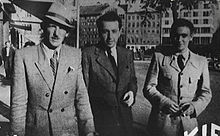
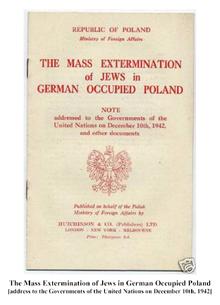
Escapes from the camps were few, but not unknown. In 1940, the Auschwitz commandant reported that "the local population is fanatically Polish and . . . prepared to take any action against the hated SS camp personnel. Every prisoner who managed to escape can count on help the moment he reaches the wall of a first Polish farmstead." According to Ruth Linn, however, escapees, particularly Jewish ones, could not rely on help from the local population or the Polish underground.
In February 1942, an escaped inmate from the Chełmno extermination camp, Jacob Grojanowski, reached the Warsaw Ghetto, where he gave detailed information about the Chełmno camp to the Oneg Shabbat group. His report, which became known as the Grojanowski Report, was smuggled out of the ghetto through the channels of the Polish underground to the Delegatura, and reached London by June 1942. It is unclear what was done with the report at that point. In the meantime, by 1 February, the United States Office of War Information had decided not to release information about the extermination of the Jews because it was felt that it would mislead the public into thinking the war was simply a Jewish problem.
By at least 9 October 1942, British radio had broadcast news of gassing of Jews to the Netherlands. In December 1942, the western Allies released the Joint Declaration by Members of the United Nations, that described how "Hitler's oft-repeated intention to exterminate the Jewish people in Europe" was being carried out and which declared that they "condemn in the strongest possible terms this bestial policy of cold-blooded extermination."
In 1942, Jan Karski reported to the Polish, British and U.S. governments on the situation in Poland, especially the destruction of the Warsaw Ghetto and the Holocaust of the Jews. He met with Polish politicians in exile including the prime minister, as well as members of political parties such as the Socialist Party, National Party, Labor Party, People's Party, Jewish Bund and Poalei Zion. He also spoke to Anthony Eden, the British foreign secretary, and included a detailed statement on what he had seen in Warsaw and Bełżec. In 1943 in London he met the then-well-known journalist Arthur Koestler. He then traveled to the United States and reported to President Franklin D. Roosevelt. His report was a major factor in informing the West.
In July 1943, Karski again personally reported to Roosevelt about the situation in Poland. During their meeting Roosevelt suddenly interrupted his report and asked about the condition of horses in occupied Poland. He also met with many other government and civic leaders in the United States, including Felix Frankfurter, Cordell Hull, William Joseph Donovan, and Stephen Wise. Karski also presented his report to media, bishops of various denominations (including Cardinal Samuel Stritch), members of the Hollywood film industry and artists, but without success. Many of those he spoke to did not believe him, or supposed that his testimony was much exaggerated or was propaganda from the Polish government in exile.
News about gassing Jews was also published in illegal newspapers of the Dutch resistance, like in the issue of Het Parool of 27 September 1943. However, the news was so unbelievable that many assumed it was merely war propaganda. The publications were halted because they were counter-productive for the Dutch resistance. Nevertheless, many Jews were warned that they would be murdered, but as escape was impossible for most of them, they preferred to believe that the warnings were false.
In September 1940, Captain Witold Pilecki, a member of the Polish underground and a soldier of the Polish Home Army, worked out a plan to enter Auschwitz and volunteered to be sent there, the only known person to volunteer to be imprisoned at Auschwitz. He organized an underground network Związek Organizacji Wojskowej (translation: "Union of Military Organizations") that was ready to initiate an uprising but it was decided that the probability of success was too low for the uprising to succeed. UMO's numerous and detailed reports became later a principal source of intelligence on Auschwitz for the Western Allies. Pilecki escaped from Auschwitz with information that became the basis of a two-part report in August 1943 that was sent to the Office of Strategic Services (OSS) in London. The report included details about the gas chambers, about "selection", and about the sterilization experiments. It stated that there were three crematoria in Birkenau able to burn 10,000 people daily, and that 30,000 people had been gassed in one day. The author wrote: "History knows no parallel of such destruction of human life." When Pilecki returned to Poland after the war the communist authorities arrested and accused him of spying for the Polish government in exile. He was sentenced to death in a show trial and was executed on 25 May 1948.
Before Pilecki escaped from Auschwitz the most spectacular escape took place on 20 June 1942, when Ukrainian Eugeniusz Bendera and three Poles, Kazimierz Piechowski, Stanisław Gustaw Jaster and Józef Lempart made a daring escape. The escapees were dressed as members of the SS-Totenkopfverbände, fully armed and in an SS staff car. They drove out the main gate in a stolen Rudolf Hoss automobile Steyr 220 with a smuggled first report from Witold Pilecki to Polish resistance about the Holocaust. The Germans never recaptured any of them.
Rudolf Vrba and Alfred Wetzler, Jewish inmates, escaped from Auschwitz in April 1944, eventually reaching Slovakia. The 32-page document they dictated to Jewish officials about the mass murder at Auschwitz became known as the Vrba-Wetzler report. Vrba had an eidetic memory and had worked on the Judenrampe, where Jews disembarked from the trains to be "selected" either for the gas chamber or slave labor. The level of detail with which he described the transports allowed Slovakian officials to compare his account with their own deportation records, and the corroboration convinced the Allies to take the report seriously.
Two other Auschwitz inmates, Arnost Rosin and Czesław Mordowicz escaped on 27 May 1944, arriving in Slovakia on 6 June, the day of the Normandy landing ( D-Day). Hearing about Normandy, they believed the war was over and got drunk to celebrate, using dollars they'd smuggled out of the camp. They were arrested for violating currency laws, and spent eight days in prison, before the Judenrat paid their fines. The additional information they offered the Judenrat was added to Vrba and Wetzler's report and became known as the Auschwitz Protocols. They reported that, between 15 and 27 May 1944, 100,000 Hungarian Jews had arrived at Birkenau, and had been killed at an unprecedented rate, with human fat being used to accelerate the burning.
The BBC and The New York Times published material from the Vrba-Wetzler report on 15 June, 20 June, 3 July and 6 July 1944. The subsequent pressure from world leaders persuaded Miklós Horthy to bring the mass deportations of Jews from Hungary to Auschwitz to a halt on 9 July, saving up to 200,000 Jews from the extermination camps.
On 14 November 2001, in the 150th anniversary issue, The New York Times ran an article by former editor Max Frankel reporting that before and during World War II, the Times had maintained a strict policy in their news reporting and editorials to minimize reports on the Holocaust. The Times accepted the detailed analysis and findings of journalism professor Laurel Leff, who had published an article the year before in the Harvard International Journal of the Press and Politics, that The New York Times had deliberately suppressed news of the Third Reich's persecution and murder of Jews. Leff concluded that New York Times reporting and editorial policies made it virtually impossible for American Jews to impress Congress, church or government leaders with the importance of helping Europe's Jews.
Death marches (1944–1945)
By mid 1944, the Final Solution had largely run its course. Those Jewish communities within easy reach of the Nazi regime had been largely exterminated, in proportions ranging from about 25 percent in France to more than 90 percent in Poland. On 5 May, Himmler claimed in a speech that "The Jewish question has in general been solved in Germany and in the countries occupied by Germany." During 1944, in any case, the task became steadily more difficult. German armies were evicted from the Soviet Union, the Balkans and Italy, and German forces—as well as forces aligned with them—were either defeated or were switching sides to the Allies. In June, the western Allies landed in France. Allied air attacks and the operations of partisans made rail transport increasingly difficult, and the objections of the military to the diversion of rail transport for carrying Jews to Poland more urgent and harder to ignore.
At this time, as the Soviet armed forces approached, the camps in eastern Poland were closed down, any surviving inmates being shipped west to camps closer to Germany, first to Auschwitz and later to Gross Rosen in Silesia. Auschwitz itself was closed as the Soviets advanced through Poland. The last 13 prisoners, all women, were killed in Auschwitz II on 25 November 1944; records show they were "unmittelbar getötet" ("killed outright"), leaving open whether they were gassed or otherwise disposed of.
Despite the desperate military situation, great efforts were made to conceal evidence of what had happened in the camps. The gas chambers were dismantled, the crematoria dynamited, mass graves dug up and the corpses cremated, and Polish farmers were induced to plant crops on the sites to give the impression that they had never existed. Local commanders continued to kill Jews, and to shuttle them from camp to camp by forced "death marches" until the last weeks of the war.
Already sick after months or years of violence and starvation, prisoners were forced to march for tens of miles in the snow to train stations; then transported for days at a time without food or shelter in freight trains with open carriages; and forced to march again at the other end to the new camp. Those who lagged behind or fell were shot. Around 250,000 Jews died during these marches.
The largest and best-known of the death marches took place in January 1945, when the Soviet army advanced on Poland. Nine days before the Soviets arrived at Auschwitz, the SS marched 60,000 prisoners out of the camp toward Wodzisław (germ. Loslau), 56 km (35 mi) away, where they were put on freight trains to other camps. Around 15,000 died on the way. Elie Wiesel and his father, Shlomo, were among the marchers:
An icy wind blew in violent gusts. But we marched without faltering. . . .
Pitch darkness. Every now and then, an explosion in the night. They had orders to fire on any who could not keep up. Their fingers on the triggers, they did not deprive themselves of this pleasure. If one of us had stopped for a second, a sharp shot finished off another filthy son of a bitch. . . .
Near me, men were collapsing in the dirty snow. Shots.
Liberation
The first major camp, Majdanek, was discovered by the advancing Soviets on 23 July 1944. Chełmno was liberated by the Soviets on 20 January 1945. Auschwitz was liberated, also by the Soviets, on 27 January 1945; Buchenwald by the Americans on 11 April; Bergen-Belsen by the British on 15 April; Dachau by the Americans on 29 April; Ravensbrück by the Soviets on the same day; Mauthausen by the Americans on 5 May; and Theresienstadt by the Soviets on 8 May. Treblinka, Sobibor, and Bełżec were never liberated, but were destroyed by the Nazis in 1943. Colonel William W. Quinn of the U.S. 7th Army said of Dachau: "There our troops found sights, sounds, and stenches horrible beyond belief, cruelties so enormous as to be incomprehensible to the normal mind."
In most of the camps discovered by the Soviets, almost all the prisoners had already been removed, leaving only a few thousand alive—7,600 inmates were found in Auschwitz, including 180 children who had been experimented on by doctors. Some 60,000 prisoners were discovered at Bergen-Belsen by the British 11th Armoured Division, 13,000 corpses lay unburied, and another 10,000 died from typhus or malnutrition over the following weeks. The British forced the remaining SS guards to gather up the corpses and place them in mass graves.
The BBC's Richard Dimbleby described the scenes that greeted him and the British Army at Belsen:
Here over an acre of ground lay dead and dying people. You could not see which was which . . . The living lay with their heads against the corpses and around them moved the awful, ghostly procession of emaciated, aimless people, with nothing to do and with no hope of life, unable to move out of your way, unable to look at the terrible sights around them . . . Babies had been born here, tiny wizened things that could not live . . . A mother, driven mad, screamed at a British sentry to give her milk for her child, and thrust the tiny mite into his arms . . . He opened the bundle and found the baby had been dead for days. This day at Belsen was the most horrible of my life.
Victims and death toll
| Victims | Killed | Source |
|---|---|---|
| Jews | 5.9 million | |
| Soviet POWs | 2–3 million | |
| Ethnic Poles | 1.8–2 million | |
| Romani | 220,000–1,500,000 | |
| Disabled | 200,000–250,000 | |
| Freemasons | 80,000-200,000 | |
| Slovenes | 20,000–25,000 | |
| Homosexuals | 5,000–15,000 | |
| Jehovah's Witnesses |
2,500–5,000 |
The number of victims depends on which definition of "the Holocaust" is used. Donald Niewyk and Francis Nicosia write in The Columbia Guide to the Holocaust that the term is commonly defined as the mass murder of more than 5 million European Jews. They further state that 'Not everyone finds this a fully satisfactory definition.' According to Martin Gilbert the total number of victims is just under six million—around 78 percent of the 7.3 million Jews in occupied Europe at the time. Timothy D. Snyder wrote that "The term Holocaust is sometimes used in two other ways: to mean all German killing policies during the war, or to mean all oppression of Jews by the Nazi regime."
Broader definitions include approximately 2 to 3 million Soviet POWs, 2 million ethnic Poles, up to 1,500,000 Romani, 200,000 handicapped, political and religious dissenters, 15,000 homosexuals and 5,000 Jehovah's Witnesses, bringing the death toll to around 11 million. The broadest definition would include 6 million Soviet civilians, raising the death toll to 17 million. A research project conducted by the United States Holocaust Memorial Museum estimated that 15 to 20 million people died or were imprisoned. R.J. Rummel estimates the total democide death toll of Nazi Germany to be 21 million. Other estimates put total casualties of Soviet Union's citizens alone to about 26 million.
Jewish
Since 1945, the most commonly cited figure for the total number of Jews killed has been six million. The Yad Vashem Holocaust Martyrs' and Heroes' Remembrance Authority in Jerusalem, writes that there is no precise figure for the number of Jews killed. The figure most commonly used is the six million attributed to Adolf Eichmann, a senior SS official. Early calculations range from about 4.2 to 4.5 million in The Final Solution (1953) by Gerald Reitlinger (arguing against higher Russian estimates), and 5.1 million from Raul Hilberg, to 5.95 million from Jacob Lestschinsky. Yisrael Gutman and Robert Rozett in the Encyclopedia of the Holocaust estimate 5.59–5.86 million. A study led by Wolfgang Benz of the Technical University of Berlin suggests 5.29–6.2 million. Yad Vashem writes that the main sources for these statistics are comparisons of prewar and postwar censuses and population estimates, and Nazi documentation on deportations and murders. Its Central Database of Shoah Victims' Names currently holds close to 3 million names of Holocaust victims, all accessible online. Yad Vashem continues its project of collecting names of Jewish victims from historical documents and individual memories.
Hilberg's estimate of 5.1 million, in the third edition of The Destruction of the European Jews, includes over 800,000 who died from "ghettoization and general privation"; 1,400,000 killed in open-air shootings; and up to 2,900,000 who perished in camps. Hilberg estimates the death toll of Jews in Poland as up to 3,000,000. Hilberg's numbers are generally considered to be a conservative estimate, as they typically include only those deaths for which records are available, avoiding statistical adjustment.
British historian Martin Gilbert arrived at a "minimum estimate" of over 5.75 million Jewish victims. Lucy S. Dawidowicz used pre-war census figures to estimate that 5.934 million Jews died (see table below).
There were about 8 to 10 million Jews in the territories controlled directly or indirectly by Germany (the uncertainty arises from the lack of knowledge about how many Jews there were in the Soviet Union). The six million killed in the Holocaust thus represent 60 to 75 percent of these Jews. Of Poland's 3.3 million Jews, over 90 percent were killed. The same proportion were killed in Latvia and Lithuania, but most of Estonia's Jews were evacuated in time. Of the 750,000 Jews in Germany and Austria in 1933, only about a quarter survived. Although many German Jews emigrated before 1939, the majority of these fled to Czechoslovakia, France or the Netherlands, from where they were later deported to their deaths. In Czechoslovakia, Greece, the Netherlands, and Yugoslavia, over 70 percent were killed. 50 to 70 percent were killed in Romania, Belgium and Hungary. It is likely that a similar proportion were killed in Belarus and Ukraine, but these figures are less certain. Countries with notably lower proportions of deaths include Bulgaria, Denmark, France, Italy, and Norway. Albania was the only country occupied by Germany that had a significantly larger Jewish population in 1945 than in 1939. About two hundred native Jews and over a thousand refugees were provided with false documents, hidden when necessary, and generally treated as honored guests in a country whose population was roughly 60% Muslim. Additionally, Japan, as an Axis member, had its own unique response to German policies regarding Jews; see Shanghai Ghetto.
| Year | Jews killed |
|---|---|
| 1933–1940 | under 100,000 |
| 1941 | 1,100,000 |
| 1942 | 2,700,000 |
| 1943 | 500,000 |
| 1944 | 600,000 |
| 1945 | 100,000 |
| Extermination Camp | Estimate of number killed |
|---|---|
| Auschwitz-Birkenau | 1 million; |
| Treblinka | 870,000; |
| Belzec | 600,000; |
| Majdanek | 79,000 – 235,000; |
| Chełmno | 320,000; |
| Sobibor | 250,000. |
This gives a total of over 3.8 million; of these, 80–90% were estimated to be Jews. These seven camps thus accounted for half the total number of Jews killed in the entire Nazi Holocaust. Virtually the entire Jewish population of Poland died in these camps.
In addition to those who died in the above extermination camps, at least half a million Jews died in other camps, including the major concentration camps in Germany. These were not extermination camps, but had large numbers of Jewish prisoners at various times, particularly in the last year of the war as the Nazis withdrew from Poland. About a million people died in these camps, and although the proportion of Jews is not known with certainty, it was estimated to be at least 50 percent. Another 800,000 to one million Jews were killed by the Einsatzgruppen in the occupied Soviet territories (an approximate figure, since the Einsatzgruppen killings were frequently undocumented). Many more died through execution or of disease and malnutrition in the ghettos of Poland before they could be deported.
By country
|
In the 1990s, the opening of government archives in Eastern Europe resulted in the adjustment of the death tolls published in the pioneering work by Hilberg, Dawidowicz and Gilbert (e.g. compare Gilbert's estimation of 2 million deaths in Auschwitz-Birkenau with the updated figure of 1 million in the Extermination Camp data box). As pointed out above, Wolfgang Benz has been carrying out work on the more recent data. He concluded in 1999:
The goal of annihilating all of the Jews of Europe, as it was proclaimed at the conference in the villa Am Grossen Wannsee in January 1942, was not reached. Yet the six million murder victims make the holocaust a unique crime in the history of mankind. The number of victims—and with certainty the following represent the minimum number in each case—cannot express that adequately. Numbers are just too abstract. However they must be stated in order to make clear the dimension of the genocide: 165,000 Jews from Germany, 65,000 from Austria, 32,000 from France and Belgium, more than 100,000 from the Netherlands, 60,000 from Greece, the same number from Yugoslavia, more than 140,000 from Czechoslovakia, half a million from Hungary, 2.2 million from the Soviet Union, and 2.7 million from Poland. To these numbers must be added all those killed in the pogroms and massacres in Romania and Transitrien (over 200,000) and the deported and murdered Jews from Albania and Norway, Denmark and Italy, from Luxembourg and Bulgaria.—Benz, Wolfgang The Holocaust: a German historian examines the genocide
Effect on Yiddish language
As the significant majority of the Jewish victims of the Holocaust were speakers of Yiddish, the Holocaust had a profound and permanent effect on the fate of Yiddish language and culture (see Yiddish Renaissance). On the eve of World War II, there were 11 to 13 million Yiddish speakers in the world. The Holocaust led to a dramatic, sudden decline in the use of Yiddish, as the extensive Jewish communities, both secular and religious, that used it in their day-to-day life were largely destroyed. Around 5 million (85%) of the victims of the Holocaust were speakers of Yiddish. Of the remaining non-Yiddish population, the Ladino speaking populations of Greece and the Balkans were also destroyed, which contributed to the extinction of this Judaeo-Spanish language.
Non-Jewish
Slavs
Himmler's Generalplan Ost (General Plan East), which was enthusiastically agreed to by Hitler in the summer of 1942, involved exterminating, expelling, or enslaving most or all Slavs from their native lands so as to make living space for German settlers, something that would be carried out over a period of 20–30 years.
Doris L. Bergen wrote that: "Like so much Nazi writing, General Plan East was full of euphemisms. ... Nevertheless its intentions were obvious. It also made clear that German policies toward different population groups were closely connected. Settlement of Germans and ethnic Germans in the east; expulsion, enslavement, and decimation of Slavs; and murder of Jews were all parts of the same plan."
According to William W. Hagen:
Generalplan Ost . . . forecast the diminution of the targeted east European peoples' populations by the following measures: Poles – 85 percent; Belarusians – 75 percent; Ukrainians – 65 percent; Czechs – 50 percent. These enormous reductions would result from "extermination through labor" or decimation through malnutrition, disease, and controls on reproduction. . . . The Russian people, once subjugated in war, would join the four Slavic-speaking nations whose fate Generalplan Ost foreshadowed.
It is a question of existence, thus it will be a racial struggle of pitiless severity, in the course of which 20 to 30 million Slavs and Jews will perish through military actions and crises of food supply.
— Heinrich Himmler spoke about Operation Barbarossa, June 1941
Ethnic Poles
German planners had in November 1939 called for "the complete destruction" of all Poles. "All Poles", Heinrich Himmler swore, "will disappear from the world". The Polish state under German occupation was to be cleared of ethnic Poles and settled by German colonists. Of the Poles, by 1952 only about 3–4 million of them were to be left in the former Poland, and only to serve as slaves for German settlers. They were to be forbidden to marry, the existing ban on any medical help to Poles in Germany would be extended, and eventually Poles would cease to exist. On 22 August 1939, just over a week before the onset of war, Hitler declared that "the object of the war is . . . physically to destroy the enemy. That is why I have prepared, for the moment only in the East, my 'Death's Head' formations with orders to kill without pity or mercy all men, women, and children of Polish descent or language. Only in this way can we obtain the living space we need." Nazi planners decided against a genocide of ethnic Poles on the same scale as against ethnic Jews; it could not proceed in the short run since "such a solution to the Polish question would represent a burden to the German people into the distant future, and everywhere rob us of all understanding, not least in that neighbouring peoples would have to reckon at some appropriate time, with a similar fate".
The actions taken against ethnic Poles were not on the scale of the genocide of the Jews. Most Polish Jews (perhaps 90% of their pre-war population) perished during the Holocaust, while most Christian Poles survived the brutal German occupation. Between 1.8 and 2.1 million non-Jewish Polish citizens perished in German hands during the course of the war, about four-fifths of whom were ethnic Poles with the remaining fifth being ethnic minorities of Ukrainians and Belarusians, the vast majority of them civilians. At least 200,000 of these victims died in concentration camps with about 146,000 being killed in Auschwitz. Many others died as a result of general massacres such as in the Warsaw Uprising where between 120,000 and 200,000 civilians were killed. The policy of the Germans in Poland included diminishing food rations, conscious lowering of the state of hygiene and depriving the population of medical services. The general mortality rate rose from 13 to 18 per thousand. Overall, about 5.6 million of the victims of World War II were Polish citizens, both Jewish and non-Jewish, and over the course of the war Poland lost 16 percent of its pre-war population; approximately 3.1 million of the 3.3 million Polish Jews and approximately 2 million of the 31.7 million non-Jewish Polish citizens died at German hands during the war. According to recent (2009) estimates by IPN, over 2.5 million non-Jewish Polish citizens died as a result of the German occupation. Over 90 percent of the death toll came through non-military losses, as most of the civilians were targeted by various deliberate actions by Nazi Germany and the Soviet Union.
A few days before the invasion of Poland, on 22 August 1939, Adolf Hitler said to his generals:
Genghis Khan led millions of women and children to slaughter—with premeditation and a happy heart. History sees in him solely the founder of a state. ... Our war aim does not consist in reaching certain lines, but in the physical destruction of the enemy. Accordingly, I have placed my death-head formations in readiness—for the present only in the East—with orders to them to send to death mercilessly and without compassion, men, women, and children of Polish derivation and language. Only thus shall we gain the living space ( Lebensraum) which we need. Who, after all, speaks today of the annihilation of the Armenians? ... Poland will be depopulated and settled with Germans. ... As for the rest, gentlemen, the fate of Russia will be exactly the same as I am now going through with in the case of Poland.
West Slavs
West Slavic populations were persecuted to some extent. By one estimate, 345,000 Czechs and Slovaks were executed or otherwise killed, and hundreds of thousands more of all of these groups were sent to concentration camps and used as forced labor. The villages of Lidice and Ležáky were completely destroyed by the Nazis; all men over 16 years of age from the village were murdered and the rest of the population was sent to Nazi concentration camps where many women and nearly all of the children were killed.
The German ethnic Sorbian population was also persecuted.
Ethnic Serbs and other South Slavs
In the Balkans, up to 581,000 Yugoslavs were killed by the Nazis and their Croatian fascist allies in Yugoslavia. German forces, under express orders from Hitler, fought with a special vengeance against the Serbs, who were considered Untermensch. The Ustaše collaborators conducted a systematic extermination of large numbers of people for political, religious or racial reasons. The most numerous victims were Serbs.
Bosniaks, Croats and others were also victims of the Jasenovac concentration camp. According to the U.S. Holocaust Museum:
"The Ustaša authorities established numerous concentration camps in Croatia between 1941 and 1945. These camps were used to isolate and murder Serbs, Jews, Roma, Muslims [Bosniaks], and other non-Catholic minorities, as well as Croatian political and religious opponents of the regime."
The USHMM and Jewish Virtual Library report between 56,000 and 97,000 persons were killed at the Jasenovac concentration camp. Yad Vashem reports an overall number of over 500,000 murders of Serbs "in horribly sadistic ways" at the hands of the Ustaše.
As per the most recent study, Bošnjaci u Jasenovačkom logoru ("Bosniaks in the Jasenovac concentration camp") by the author Nihad Halilbegović, at least 103,000 Bosniaks (Bosnian Muslims) perished during the Holocaust at the hands of the Nazi regime and the Croatian Ustaše. According to the study, "unknown is the full number of Bosniaks who were murdered under Serb or Croat alias or national name" and "a large numbers of Bosniaks were killed and listed under Roma populations", therefore in advance sentenced to death and extermination.
Excluding Slovenes under Italian rule, between 20,000 and 25,000 Slovenes were killed by Nazis or fascists (counting only civilian victims).
Albanian collaborationists cooperated with the Nazis and what followed was an extensive persecution of non-Albanians (mostly Serbs) by Albanian fascists. Most of the war crimes were perpetrated by the Albanian SS Skenderbeg Division and the Balli Kombëtar. 3,000 to 10,000 Kosovo Serbs were murdered by the Albanians during the war, and another 30,000 to 100,000 were expelled.
East Slavs
Soviet civilian populations in the occupied areas were also heavily persecuted (in addition to the barbarity of the Eastern Front frontline warfare manifesting itself in episodes such as the siege of Leningrad in which more than 1 million civilians died). Thousands of peasant villages across Russia, Belarus and Ukraine were annihilated by German troops. Bohdan Wytwycky has estimated that as many as one quarter of all Soviet civilian deaths at the hands of the Nazis and their allies were racially motivated. The Russian Academy of Sciences in 1995 reported civilian victims in the USSR at German hands, including Jews, totaled 13.7 million dead, 20% of the 68 million persons in the occupied USSR. This included 7.4 million victims of Nazi genocide and reprisals.
In Belarus, Nazi Germany imposed a regime in the country that was responsible for burning down some 9,000 villages, deporting some 380,000 people for slave labour, and killing hundreds of thousands of civilians. More than 600 villages, like Khatyn, were burned along with their entire population and at least 5,295 Belarusian settlements were destroyed by the Nazis and some or all of their inhabitants killed. Tim Snyder states: "Of the nine million people who were on the territory of Soviet Belarus in 1941, some 1.6 million were killed by the Germans in actions away from battlefields, including about 700,000 prisoners of war, 500,000 Jews, and 320,000 people counted as partisans (the vast majority of whom were unarmed civilians."
The German racists assigned the Slavs to the lowest rank of human life, from which the Jews were altogether excluded. The Germans thus looked upon Slavs as people not fit to be educated, not able to govern themselves, worthy only as slaves whose existence would be justified because they served their German masters. Hitler's racial policy with regard to the Slavs, to the extent that it was formulated, was "depopulation." The Slavs were to be prevented from procreating, except to provide the necessary continuing supply of slave laborers.
— Lucy Dawidowicz, The Holocaust and the historians
Soviet POWs
According to Michael Berenbaum, between two and three million Soviet prisoners-of-war—or around 57 percent of all Soviet POWs—died of starvation, mistreatment, or executions between June 1941 and May 1945, and most those during their first year of captivity. According to other estimates by Daniel Goldhagen, an estimated 2.8 million Soviet POWs died in eight months in 1941–42, with a total of 3.5 million by mid-1944. The USHMM has estimated that 3.3 million of the 5.7 million Soviet POWs died in German custody—compared to 8,300 of 231,000 British and American prisoners. The death rates decreased as the POWs were needed to work as slaves to help the German war effort; by 1943, half a million of them had been deployed as slave labor.
Romani people
| “ |
[T]hey wish to toss into the Ghetto everything that is characteristically dirty, shabby, bizarre, of which one ought to be frightened and which anyway had to be destroyed. |
” |
|
— Emmanuel Ringelblum on the Roma. |
||
Because the Roma and Sinti are traditionally a private people with a culture based on oral history, less is known about their experience of the genocide than about that of any other group. Yehuda Bauer writes that the lack of information can be attributed to the Roma's distrust and suspicion, and to their humiliation, because some of the basic taboos of Romani culture regarding hygiene and sexual contact were violated at Auschwitz. Bauer writes that "most [Roma] could not relate their stories involving these tortures; as a result, most kept silent and thus increased the effects of the massive trauma they had undergone."
The treatment of Romanis was not consistent in the different areas that Nazi Germany conquered. In some areas (e.g. Luxembourg and the Baltic countries), the Nazis killed virtually the entire Romani population. In other areas (e.g. Denmark, Greece), there is no record of Romanis being subjected to mass killings.
Donald Niewyk and Frances Nicosia write that the death toll was at least 130,000 of the nearly one million Roma and Sinti in Nazi-controlled Europe. Michael Berenbaum writes that serious scholarly estimates lie between 90,000 and 220,000. A study by Sybil Milton, senior historian at the U.S. Holocaust Memorial Museum, calculated a death toll of at least 220,000 and possibly closer to 500,000, but this study explicitly excluded the Independent State of Croatia where the genocide of Romanies was intense. Martin Gilbert estimates a total of more than 220,000 of the 700,000 Romani in Europe. Ian Hancock, Director of the Program of Romani Studies and the Romani Archives and Documentation Centre at the University of Texas at Austin, has argued in favour of a higher figure of between 500,000 and 1,500,000. Hancock writes that, proportionately, the death toll equaled "and almost certainly exceed[ed], that of Jewish victims."
Before being sent to the camps, the victims were herded into ghettos, including several hundred into the Warsaw Ghetto. Further east, teams of Einsatzgruppen tracked down Romani encampments and murdered the inhabitants on the spot, leaving no records of the victims. They were also targeted by the puppet regimes that cooperated with the Nazis, e.g. the Ustaše regime in Croatia, where a large number of Romani were killed in the Jasenovac concentration camp. The genocide analyst Helen Fein has stated that the Ustashe killed virtually every Romani in Croatia.
In May 1942, the Romani were placed under the same labor and social laws as the Jews. On 16 December 1942, Heinrich Himmler, Commander of the SS and regarded as the "architect" of the Nazi genocide, issued a decree that "Gypsy Mischlinge (mixed breeds), Romani, and members of the clans of Balkan origins who are not of German blood" should be sent to Auschwitz, unless they had served in the Wehrmacht. On 29 January 1943, another decree ordered the deportation of all German Romani to Auschwitz.
This was adjusted on 15 November 1943, when Himmler ordered that, in the occupied Soviet areas, "sedentary Gypsies and part-Gypsies (Mischlinge) are to be treated as citizens of the country. Nomadic Gypsies and part-Gypsies are to be placed on the same level as Jews and placed in concentration camps." Bauer argues that this adjustment reflected Nazi ideology that the Roma, originally an Aryan population, had been "spoiled" by non-Romani blood.
Persons of colour
The number of black people in Germany when the Nazis came to power is variously estimated at 5,000–25,000. It is not clear whether these figures included Asians. According to the United States Holocaust Memorial Museum, Washington, D.C., "The fate of black people from 1933 to 1945 in Nazi Germany and in German-occupied territories ranged from isolation to persecution, sterilization, medical experimentation, incarceration, brutality, and murder. However, there was no systematic program for their elimination as there was for Jews and other groups." Meanwhile, Afrikaaners, Berbers, Iranians and Pre-Partition Indians were classified as Aryans, so not persecuted (see main article).
Disabled and mentally ill
| “ |
Our starting-point is not the individual, and we do not subscribe to the view that one should feed the hungry, give drink to the thirsty or clothe the naked—those are not our objectives. Our objectives are entirely different. They can be put most crisply in the sentence: we must have a healthy people in order to prevail in the world. |
” |
|
— Joseph Goebbels, 1938. |
||
Action T4 was a program established in 1939 to maintain the genetic "purity" of the German population by killing or sterilizing German and Austrian citizens who were judged to be disabled or suffering from mental disorder.
Between 1939 and 1941, 80,000 to 100,000 mentally ill adults in institutions were killed; 5,000 children in institutions; and 1,000 Jews in institutions. Outside the mental health institutions, the figures are estimated as 20,000 (according to Dr. Georg Renno, the deputy director of Schloss Hartheim, one of the euthanasia centers) or 400,000 (according to Frank Zeireis, the commandant of Mauthausen concentration camp). Another 300,000 were forcibly sterilized. Overall it has been estimated that over 200,000 individuals with mental disorders of all kinds were put to death, although their mass murder has received relatively little historical attention. Along with physically disabled, people suffering from dwarfism were persecuted as well. Many were put on display in cages and experimented on by the Nazis. Despite not being formally ordered to take part, psychiatrists and psychiatric institutions were at the centre of justifying, planning and carrying out the atrocities at every stage, and "constituted the connection" to the later annihilation of Jews and other "undesirables" in the Holocaust. After strong protests by the German Catholic and Protestant churches on 24 August 1941 Hitler ordered the cancellation of the T4 program.
The program was named after Tiergartenstraße 4, the address of a villa in the Berlin borough of Tiergarten, the headquarters of the General Foundation for Welfare and Institutional Care, led by Philipp Bouhler, head of Hitler's private chancellery (Kanzlei des Führer der NSDAP) and Karl Brandt, Hitler's personal physician.
Brandt was tried in December 1946 at Nuremberg, along with 22 others, in a case known as United States of America vs. Karl Brandt et al., also known as the Doctors' Trial. He was hanged at Landsberg Prison on 2 June 1948.
Homosexuals
Between 5,000 and 15,000 homosexuals of German nationality are estimated to have been sent to concentration camps. James D. Steakley writes that what mattered in Germany was criminal intent or character, rather than criminal acts, and the "gesundes Volksempfinden" ("healthy sensibility of the people") became the leading normative legal principle. In 1936, Himmler created the Reich Central Office for the Combating of Homosexuality and Abortion. Homosexuality was declared contrary to "wholesome popular sentiment," and homosexuals were consequently regarded as "defilers of German blood." The Gestapo raided gay bars, tracked individuals using the address books of those they arrested, used the subscription lists of gay magazines to find others, and encouraged people to report suspected homosexual behavior and to scrutinize the behaviour of their neighbours.
Tens of thousands were convicted between 1933 and 1944 and sent to camps for "rehabilitation", where they were identified by yellow armbands and later pink triangles worn on the left side of the jacket and the right trouser leg, which singled them out for sexual abuse. Hundreds were castrated by court order. They were humiliated, tortured, used in hormone experiments conducted by SS doctors, and killed. Steakley writes that the full extent of gay suffering was slow to emerge after the war. Many victims kept their stories to themselves because homosexuality remained criminalized in postwar Germany. Around two percent of German homosexuals were persecuted by Nazis.
The political left
German communists, socialists and trade unionists were among the earliest domestic opponents of Nazism and were also among the first to be sent to concentration camps. Hitler claimed that communism was a Jewish ideology which the Nazis termed " Judeo-Bolshevism". Fear of communist agitation was used as justification for the Enabling Act of 1933, the law which gave Hitler his original dictatorial powers. Hermann Göring later testified at the Nuremberg Trials that the Nazis' willingness to repress German communists prompted President Paul von Hindenburg and the German elite to cooperate with the Nazis. MI6 assisted the Gestapo via "the exchange of information about Communism", and, as late as October 1937, the head of the British agency's Berlin station, Frank Foley, described his relationship with Heinrich Müller's so-called communism expert as "cordial".
Hitler and the Nazis also hated German leftists because of their resistance to the party's racism. Many leaders of German leftist groups were Jews, and Jews were especially prominent among the leaders of the Spartacist uprising in 1919. Hitler already referred to Marxism and " Bolshevism" as a means of "the international Jew" to undermine "racial purity" and survival of the Nordics or Aryans, as well to stir up socioeconomic class tension and labor unions against the government or state-owned businesses. Within the concentration camps such as Buchenwald, German communists were privileged in comparison to Jews because of their "racial purity".
Whenever the Nazis occupied a new territory, members of communist, socialist, or anarchist groups were normally to be the first persons detained or executed. Evidence of this is found in Hitler's infamous Commissar Order, in which he ordered the summary execution of all political commissars captured among Soviet soldiers, as well as the execution of all Communist Party members in German held territory. Einsatzgruppen carried out these executions in the east.
Nacht und Nebel (German for "Night and Fog") was a directive (German: Erlass) of Hitler on 7 December 1941 signed and implemented by Chief of Staff of the Armed Forces Wilhelm Keitel, resulting in kidnapping and disappearance of many political activists throughout Nazi Germany's occupied territories.
Freemasons
In Mein Kampf, Hitler wrote that Freemasonry had "succumbed" to the Jews: "The general pacifistic paralysis of the national instinct of self-preservation begun by Freemasonry is then transmitted to the masses of society by the Jewish press." Within the Reich, however, the "threat" posed by Freemasons was not considered serious from the mid-1930s onwards. Heydrich even established a Freemasonry museum—at which Eichmann spent some time early in his SD career—for what he regarded as a "disappeared cult". Similarly, Hitler was happy to issue a proclamation on 27 April 1938 whose third point lifted restrictions on Party membership for former Freemasons, "provided the applicants had not served with the Lodge as highdegree members." The Führer still maintained Freemasonry within his conspiratorial outlook, but its adherents were not persecuted in a systematic fashion like groups such as the Jews. Those Freemasons who were sent to concentration camps as political prisoners were forced to wear an inverted red triangle.
The United States Holocaust Memorial Museum believes that, "because many of the Freemasons who were arrested were also Jews and/or members of the political opposition, it is not known how many individuals were placed in Nazi concentration camps and/or were targeted only because they were Freemasons." However, the Grand Lodge of Scotland estimates the number of Freemasons executed between 80,000 and 200,000.
Jehovah's Witnesses
Refusing to pledge allegiance to the Nazi party or to serve in the military, roughly 12,000 Jehovah's Witnesses were forced to wear a purple triangle and were placed in camps where they were given the option of renouncing their faith and submitting to the state's authority. Between 2,500 and 5,000 were killed. Historian Detlef Garbe, director at the Neuengamme (Hamburg) Memorial, writes that "no other religious movement resisted the pressure to conform to National Socialism with comparable unanimity and steadfastness."
Uniqueness
Dr. Shimon Samuels, director for International Liaison of the Simon Wiesenthal Centre, describes the acrimonious debate that exists between "specifists" and "universalists". The former fear debasement of the Holocaust by invidious comparisons, while the latter places the Holocaust alongside non-Jewish experiences of mass extermination as part and parcel of the global context of genocide. Dr. Samuels considers the debate, ipso facto, to dishonour the memory of the respective victims of each genocide. In his words, "Each case is specific as a threshold phenomenon, while each also adds its unique memory as signposts along an incremental continuum of horror." Peter Novick argued: "A moment's reflection makes clear that the notion of uniqueness is quite vacuous . . . [and], in practice, deeply offensive. What else call all of this possibly mean except 'your catastrophe, unlike ours, is ordinary'". Adam Jones, professor at the University of British Columbia Okanagan, believes that claims of uniqueness for the Holocaust have become less common since the 1994 Rwandan genocide. In 1997, the publication of The Black Book of Communism led to further debate on the comparison between Soviet and Nazi crimes; the book argued that Nazi crimes were not very different from the Soviet ones, and that Nazi methods were to a significant extent adopted from Soviet methods; in the course of the debate, the term "Red Holocaust" appeared in discourse. In The Holocaust Industry, Norman Finkelstein writes that the uniqueness theory first appeared in public discourse in 1967, but that it does not figure in scholarship of the Nazi Holocaust. Steven Katz of Boston University has argued that the Holocaust is the only genocide that has occurred in history, and defines "Holocaust" to include only "the travail of European Jewry" and not other victims of the Nazis.
